Complete INT 220 Guide: Master Global Dimensions in Business Milestones, Discussions, and Assignments
Published: 2025-04-30
Modified: 2025-06-19
Table of Contents
Introduction
This guide offers a complete overview of INT 220: Global Dimensions in Business, covering all major discussions, assignments, and milestones. It provides step-by-step instructions, example responses, and useful tips to help students confidently complete each module and succeed throughout the course.
Step-by-Step Guide for INT 220 1-1 Discussion: Global Events and Local Supplies
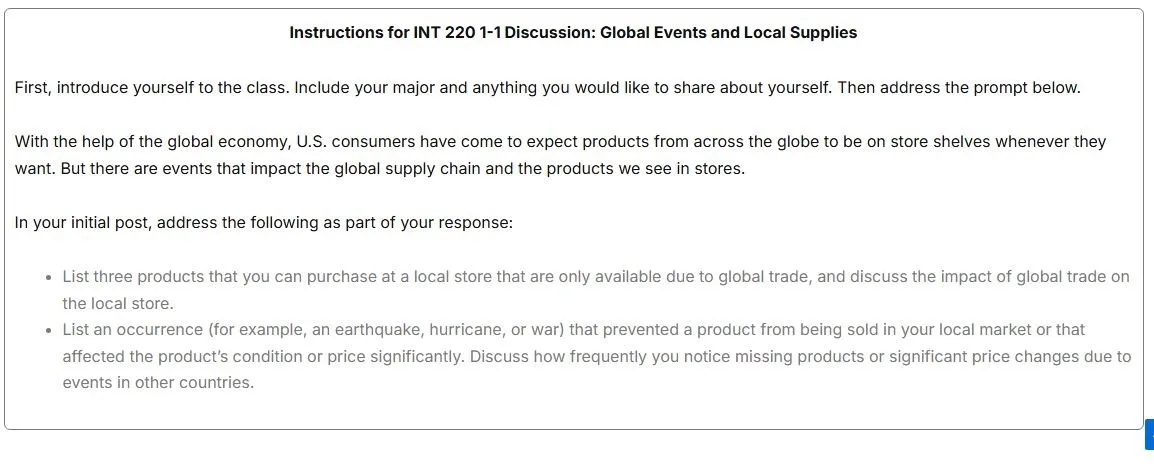
This Owlisdom How-To Guide intends to provide Global Dimensions in Business students with detailed and thorough instructions and guidelines about solving the 1-1 Discussion: Local Supplies and Global Events. The INT 220 Discussion posts, Assignments, and Module Milestones will be answered by us with dummy solutions. All, hold on tight, we’ve a long way to go.
Follow the guidelines below to solve the INT 220 1-1 Discussion: A global event and local supply with confidence. If you hit a snag or feel befuddled, stay calm, we’ve got you. As you walk through each of the How-To Guides, there is a dummy solution attached. Thank you later 🙂
List three products that can be purchased at a local store but are only available due to global trade, and discuss the impact of international trade on the local store.
Understanding the Impact of Global Trade
For 1-1 Discussion, state your major and include a fact about yourself that you are interested in, in one sentence, to begin building a personal connection with your classmates. You can also add why you decided to take INT 220 and what you hope this
will do for you. Then, we will dive into the vital part of the 1-1 Discussion: Knowledge about the effect of global trade on local products.
List Three Globally Sourced Products
For this part, you need to identify three products that are bought from your local store that are also bought globally. Consider what these products tell us about the connection between global trade and how that trade affects regional availability.
Discuss Global Trade’s Impact
Finally, let us discuss how global trade has affected Global Events and Local Supplies, and also determine how it affects the product range, affordability, availability, and communication in local stores. While you can help increase the selection for U.S. consumers, you can also introduce vulnerabilities.
Example
I am majoring in International Business Studies, and I am (and have always been) interested in understanding market profile trends of (and their impact on) local economies. In the Global Dimension findings in a business brief, I will talk about how global events impact local product supplies.
Three Globally Sourced Products are categorized into salads, protein, and condiments.
Coffee from Brazil: Bold testament to the world’s need for all kinds of coffee and the power of Brazilian agriculture.
Pasta from Italy: In reflection of the appreciation of the world to genuine Italian Cuisine and of the exchange of attitudes and customs in the sphere of international trade.
Cheese from France: A reminder of the importance of the global market in ensuring that regional specialties will reach consumers from across the globe, and with more culinary diversity.
Global Trade’s Impact
As per the research article by Cohen and Kouvelis (2021), Global trade enlarges product variety, enlarges availability, and affects pricing in nearby stores, giving U.S. purchasers large amounts of choices while giving the supply chain weaknesses to the neighborhood markets.
List an occurrence (for example, an earthquake, hurricane, or war) that prevented a product from being sold in your local market or that significantly affected the product’s condition or price. Discuss how frequently you notice missing products or significant price changes due to events in other countries.
Identifying Global Supply Chain Vulnerabilities
Global supply chain vulnerabilities must be identified. Discussion 1 presents the process by which these vulnerabilities are created and assessed for frequency and impact.
List an Occurrence Affecting Local Markets
Choose a particular global event (e.g., natural disaster, geopolitical tension) that changed the supply chain, which resulted in the shortage of the product or price changes for it in your local market.
Analyze Impact and Frequency
Talk about the damage to local markets and how often you have seen a disruption or huge price changes caused by international events.
Example
Affecting the Occurrence of Local Markets
This period of the 2020 Pandemic significantly disrupted global supply chains and caused many product shortages and price rises of many commodities through local U.S. markets (Xu et al., 2020). Paradoxically, medical supplies, food items, and technology products were severely disrupted by lockdowns and transport restrictions. The approach expectation was severe: there were frequent shortages of essentials, and not so noticeable but still frequent price hikes. Scale does vary, but such disruptions happen periodically, showing the fragility of the global supply chain to international events.
In your responses to two or more of your peers, address the following:
• Which product are you most surprised is available only due to globalization, and why?
• After seeing examples of events that affected the availability of local products or services, what category of events do you think would affect the global supply chain most often, and why?
Peer Responses
I consider it necessary to react and answer to peers' queries. There are times when we have to answer questions better and professionally. INT 220 may have some discussion posts, like 1-1 Discussion, which may request peers’ responses. All you have to do is follow some instructions, and you can answer any question by the end
· For your responses to classmates, choose a globally sourced product that you find surprising and describe why you use a credible resource.
· Describe which category of global events (natural disasters, political unrest, etc.) might impact the global supply chain most frequently, and why.
Guidelines for Crafting Your Response
· Be Concise and Clear: Simple explanations, yet informative, so that you can see the key points that prove that business has global dimensions.
· Use Real-Life Examples: When discussing products and events, use real-world examples that highlight the real-world consequences of global trade on local markets.
· Engage Critically: Examine critically the nature of the examples you and your peers offer and deepen your understanding of how events are global and are felt locally.
· Reflect on Personal Observations: Write the analysis incorporating your observations about product availability and price changes, and infuse some of your thoughts into this comprehensive objective analysis of your industry.
· Contribute Constructively: Responding to peers, you can offer insightful comments the comments add to the peer’s observation and nurture a collaborative learning environment.
Example Peer Response 01
Hey Alex! Nice post. I did not know that every daily item that is nonexistent here is given by globalization. After all, it’s a small world. According to me, pandemics and natural disasters have the most pronounced impact on the supply chains of these events. But because they disrupt transportation and production so quickly and so broadly, it is no wonder that we indeed see such immediate effects on availability and prices. (Gunessee & Subramanian, 2020).
References
Gunessee, S., & Subramanian, N. (2020). Ambiguity and its coping mechanisms in supply chains: lessons from the COVID-19 pandemic and natural disasters. International Journal of Operations & Production Management, 40(7/8), 1201–1223. https://doi.org/10.1108/IJOPM-07-2019-0530
According to the instructions of INT 220 1-1 Discussion, we are supposed to write two peer responses. I have addressed the given instructions in one response. Following these instructions, you can quickly write your peer responses to 1-1 Discussions without a hassle.
Closing
Following these guidelines will be able to satisfy the demands of the assignment while acquiring a more profound knowledge of the far relationships between global events and native abode supplies for that related to the comprehending international business and its effects on the U.S. market. We intend this INT 220 1-1 Discussion post would be ideal for you. Good luck!
In the next module of INT-220, Benefits of Global Expansion, we will find out.
Step-by-Step Guide for INT 220 1-2 Assignment: Benefits of Global Expansion
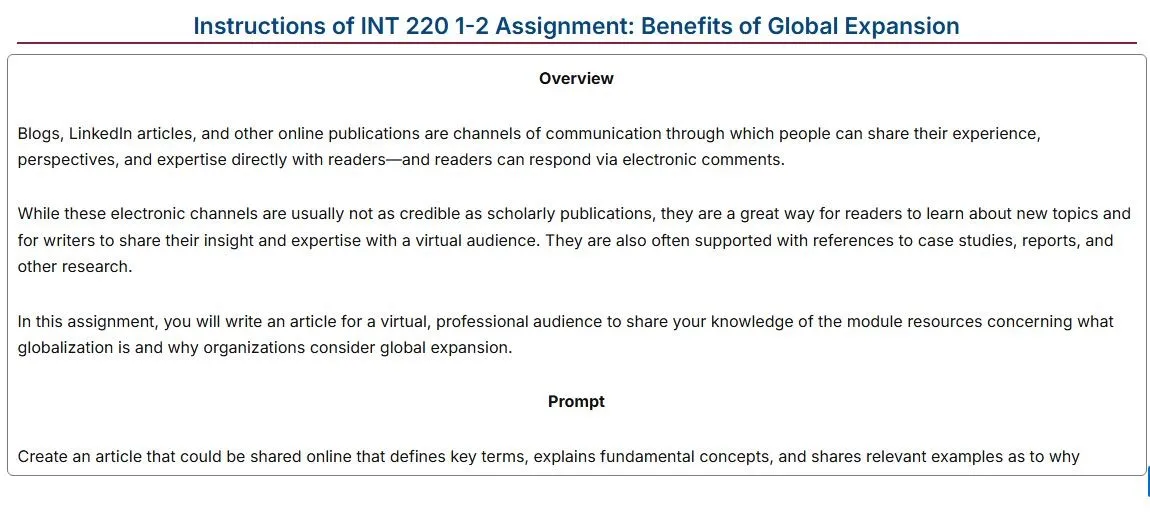
Welcome to our guide on tackling “1-2 Assignment: ‘Global Dimensions in Business,’ designed for an int-220- global dimensions in business. This Owlisdom How-To will simplify and make the U.S. economy and market’s complexity much more understandable. In this part, we shall be covering the key aspects of your assignment, which are about differentiating the business environment, exploring organizational examples, the benefits of the expansion, and the importance of ethical considerations.
Differentiate between domestic and international business environments by defining and providing critical characteristics of each type, using supporting evidence.
Understanding Globalization and Global Expansion in Global Dimensions in Business
Globalization is an essential part of understanding the 1-2 assignment benefits of global expansion to understand the international market.
In this article, I’ll cover all the parts of the instruction one by one and we’ll also see the example solved by us for each part. Let’s start!
Start by Defining
· Distinguish the domestic from the international business environments.
· Domestic climate deals with the country’s border, local regulations, market goal, and familiarity in its operation.
· The international environment however, extends the borders beyond these borders and requires understanding different legal systems, economic policies, along with controversial cultural nuances.
Use Supporting Evidence in 1-2 assignment: Benefits of global expansion
· Study from credible sources, like Market analysis reports or research guides how companies deal with these environments.
· This evidence drives a wedge between domestic and international settings.
Example
COUNTRY SELECTED: INDIA

According to Diaz (2022), a business environment is that of a business operating within the borders of the country and observing its local regulations and market trends. A domestic market is based on cultural nuances, whereas the international business scene. For a U.S. perspective, it means acting outside of American borders, which means understanding other legal systems, economic policies, and even culturalacíonls (Diaz, 2022).
American domestic US and foreign companies focus on complying with America laws, using their understanding of the American Socio economic framework and tapping into the preferences of their local consumers to receive success. However, the success of US companies going abroad requires their adaptation to different foreign regulations; the understanding of different market tendencies; and cultural sensitivity (Rivero-Gutierrez et al., 2023).
Identify examples of domestic and international organizations and explain, using supporting evidence, how they meet the criteria for each type of organization.
Identifying Example Organizations
The int 220 global dimensions assignment parts that benefit from global expansion tasks require you to provide examples. Generating examples for the INT 1-2 Assignment is based on following the instructions below..
· Domestic and International Examples: They suggest choosing companies that represent each category. If you are in domestic, think of a U.S.-based company that has primary operations in the country. For international, make a choice of a company with a powerful experience in various countries.
· Criteria Matching: Explain how these organizations are ideally suited to these categories. You can use financial reports, presence in the market, and operational strategies as proof.
Example
One of the best US domestic examples of such organizations is a fast food chain, In-N-Out Burger, which only operates in the United States (Sun, 2022). The U.S.-based technology company Apple Inc. is headquartered, has retail stores, and has operations globally (Pan, 2024). Within a domestic room, a classic example of a domestic organization is an In-N-Out Burger, who concentrate on the operation and has a menu list directed at the American governmental market. International Organization: Apple Inc.
Explain the key benefits of international and global expansion for domestic businesses, providing specific examples and using supporting evidence.
Benefits of Global Expansion
The most important aspect of the 1-2 assignment benefits of global expansion is figuring out what the 1-2 assignment benefits of global expansion are. You can work on this INT 220 1-2 Assignment efficiently by following the rules given below.
· Discuss why going global can benefit with market diversification, new customer access, and improved innovation capabilities.
· Practice with real life situations in which U.S. based companies decided to open in international market and gain from above. Specific reference to outcome specific such as growth in revenue market shares.
Example
U.S. businesses expand abroad to diversify the markets they serve, to have a broader customer base, and to come up with innovations. (Goncharenko et al., 2023) Shows that underscoring the capacity of getting to global markets, Netflix jumped into 190 and more nations, boosting its subscribers and income exponentially. Like Starbucks’ global presence, Starbucks brought new flavors and new concepts to the U.S., and it’s inspired by that kind of global insight to fuel innovation (Dolbec et al., 2022). The application of these global dimensions in business assignment strategies contributes to strengthening financial stability, market share, and introduces new ideas and products onto the domestic market, which further works towards binding global expansion’s interconnectiveness and benefits to one another.
Explain the role of ethics in making a business brief for leadership expansion to a new market and how ethical decision-making frameworks can help make these decisions. Use supporting evidence as appropriate.
Navigating Ethical Considerations
Let us look at this part of the INT 220 1-2 Assignment. In it, we discuss ethical considerations in decision-making frameworks.
· Ethics in Expansion: Small Commerce and Entrepreneurs gives recognition to the importance of ethical considerations when seeking to expand into new markets that impact business. Talk about barriers such as culture differences, labor standards, and regulatory responsibilities.
· Decision-Making Frameworks: Talk a bit about a couple of ethical frameworks that can inform decision-making processes. Put forward how these could be made to apply to hypothetical expansion scenarios so that ethical and beneficial decisions are made.
Example
· Ethics in Expansion
This is particularly important when you are in the world of business and you want to go into the new markets, where cultural sensitiveness, labor practices and regulatory compliances are very important to be considered, to work ethically for smooth business.
· Decision-Making Frameworks
Ethical frameworks help businesses assess the broader impact of their actions and ensure their work contributes positively to new markets and their local work synergizes with the norms and values in place.
Conclusion in INT 220 1-2 assignment: benefits of global expansion
End 1-2 with assignment benefits of global expansion, of which understanding global dimensions in business is a crucial aspect for international expansion success. As always, clarity, evidence, and ethics are your keys to opening up a fuller sense of “220 global dimensions in business.”
Example
To be successful internationally, the importance of understanding global dimensions in business is paramount. You need to be able to understand the global business dynamics — clarity, supporting evidence, and ethical considerations.
Closing
This How-To Guide will equip you with the instructions and guidelines to analyze and differentiate between domestic and international business environments, allowing you to solve the INT 220 1-2 Assignment: Benefits of Global Expansion, thought through and executed. Wishing you luck on your assignment. Good luck 🙂
Before that we did INT 220 global dimensions in business. Don’t forget to check out our complete solution for INT 220 2-1 Milestone One, we have to do Milestone One of INT 220 next week.
FAQs
What differentiates a domestic from an international business environment?
The 1-2 Assignment defines that a domestic environment is based on one country, even though the laws and culture are local, and an international business analyst working translates into a cross environment where it needs the global understanding.
Can you give examples of companies that are purely domestic and those that are international?
Apple is a global company, and In-N-Out Burger is purely domestic, operating only in the U.S. For more detailed information, look at the Global Dimensions in Business brief template 1-2 Assignment.
What are the main benefits of global expansion for companies?
Global expansion offers market diversification, access to new customer bases, and enhanced innovation capabilities. 1-1 Assignment: More detailed notes about this motif are available in the Benefits of Global Expansion.
References
Dolbec, P.-Y., Arsel, Z., & Aboelenien, A. (2022). A Practice Perspective on Market Evolution: How Craft and Commercial Coffee Firms Expand Practices and Develop Markets—Pierre-Yann Dolbec, Zeynep Arsel, Aya Aboelenien, 2022. https://journals.sagepub.com/doi/full/10.1177/00222429221093624
Pan, Y. (2024). Apple’s Secret to Being Successful: Research on Apple’s Commercial Marketing Strategy Based on Multi-marketing Framework. Journal of Education, Humanities and Social Sciences, pp. 27, 413–418. https://doi.org/10.54097/c8qj3c65
Introduction to INT 220 2-1 Assignment
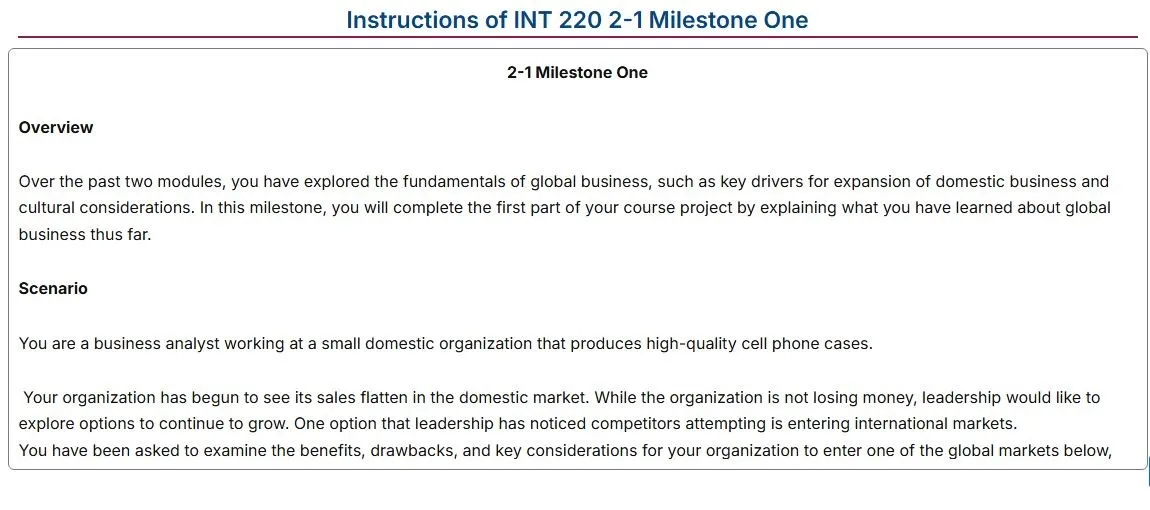
In INT 220 Global Business, today (INT 220 2-1 Milestone One), we are going to summarize what we have learned and discussed in INT 220 Global Business.
The INT 220 Business Brief Template will be given to us to fill out to solve INT 2-1 Milestone One. It asks us to behave as a business analyst working at a small domestic organization. We are in the business of producing high-quality cell phone cases. For reference, we are supposed to talk about the reason behind global expansion in the international market as well as how can we broaden our business in other countries. This practical application will ready you for real world business situations.
To solve INT 220 milestone one, I will use the SNHU template.
I will choose India for the INT 220 course resources project, and will also provide example solution accordingly. We will make use of these examples, which will help you learn how to apply the concepts on your own project.
State the country you have selected to use for your course project.
Country Selection
As your INT 7-1 Project Submission in INT 220 will be based on the selected country, this is a crucial step in the Milestones of INT 220. Check out these steps below for deciding what country to choose for INT 2-1 Milestone One.
· When choosing a country, consider economic stability, market size, cultural aspects, and legal environment.
· Describe a hypothetical or real country as a focus of your guide. Suggest a reason why you chose to focus on this hypothetical or real country.
Explain the key benefits of successful global expansion for domestic organizations.
Purpose Of Global Expansion
We already discussed the benefits of global expansions in INT 220 1-2 Assignment: Benefits of Global Expansion. In this post, we shall explain what benefits a domestic business could enjoy by entering a foreign market.
· Spend some time to discuss about the potential benefits in entering in an international market, English revenue and market share.
· By examples or case studies, use them to illustrate how global expansion helps facilitate company growth.
Example
PURPOSE OF GLOBAL EXPANSION
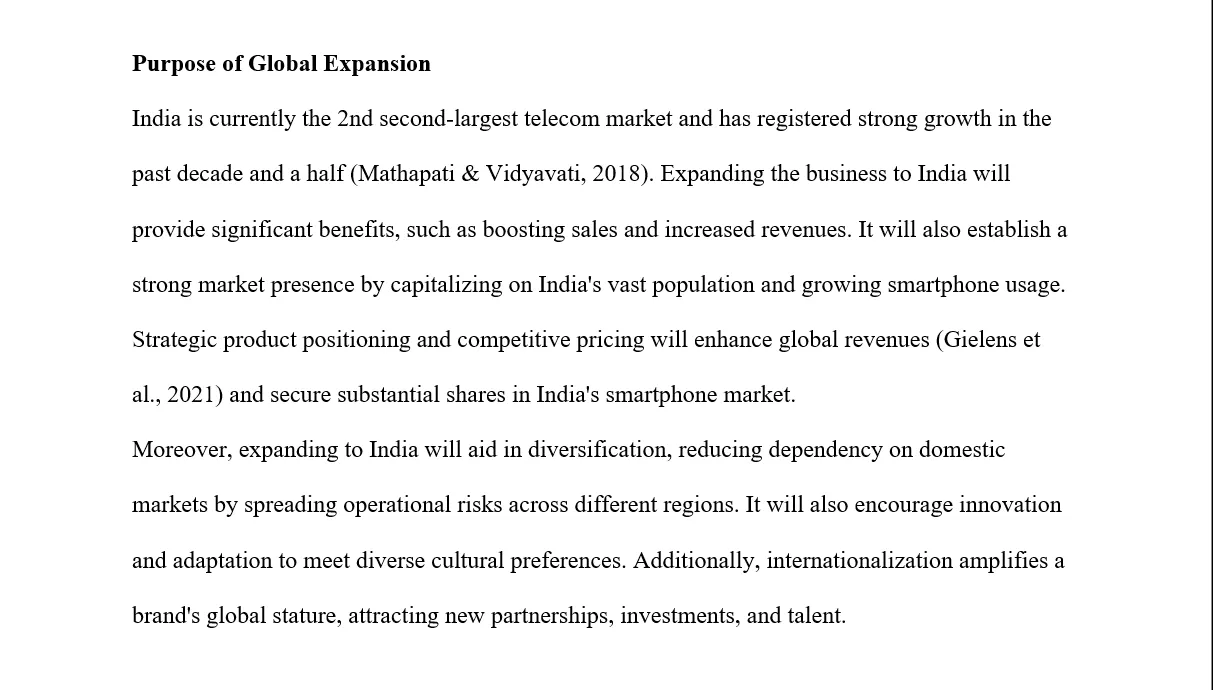
Explain how a domestic organization’s global expansion can impact business operations in strategic planning, marketing, supply-chain management, human resources, etc.
Business Impacts Of Global Business
This section in INT 2-1 Milestone One will talk about the impact of globalization on global business.
· Strategic Planning: This is a guide to modify business models to international markets (product or service alteration and pricing strategy adjustment).
· Marketing: Serve as the basis from which to offer strategies to localize marketing efforts to fit with the culture and consumer preferences of the new market.
· Supply-Chain Management: It provides insights into overcoming logistical challenges and keeping an efficient supply chain in a global context.
· Human Resources: Helps provide some insight into how to overcome logistical challenges and maintain an efficient supply chain within a global context.
Example
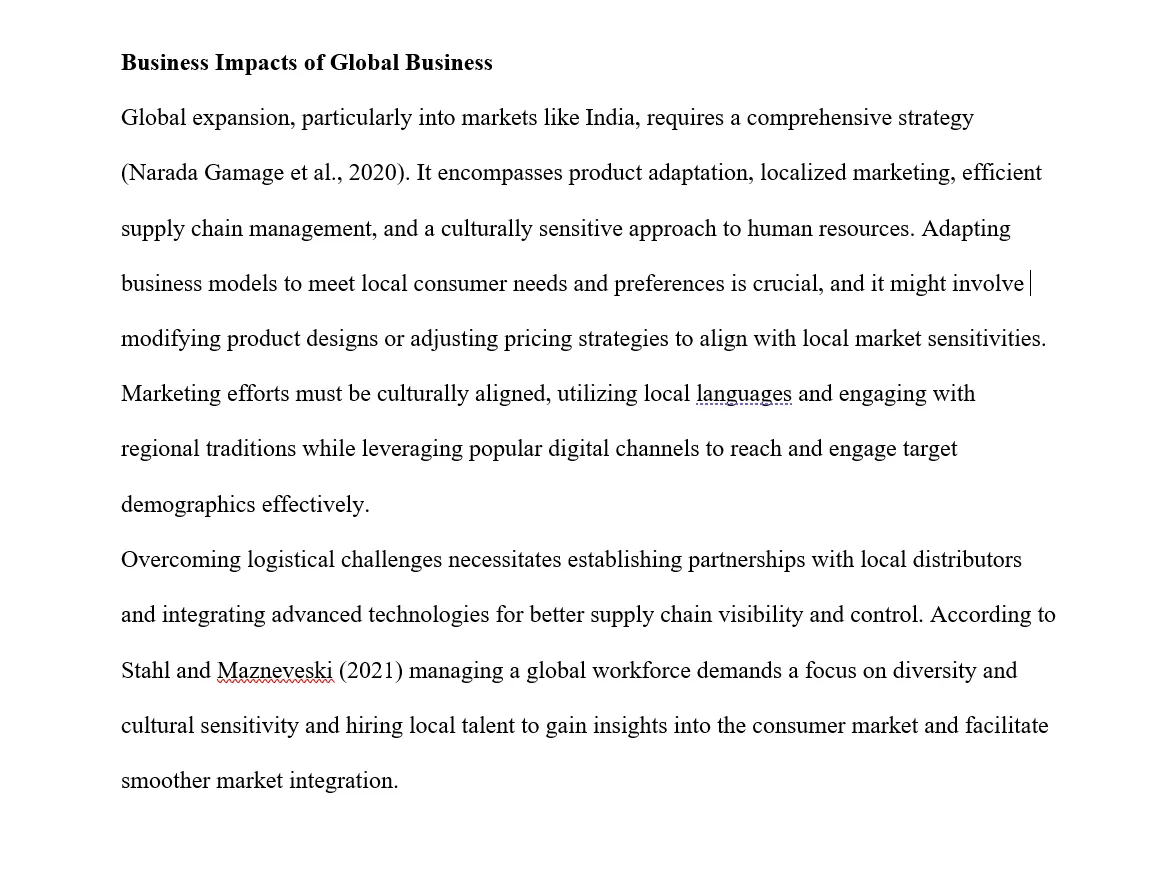
Explain how the global expansion of organizations has impacted society, citing specific examples regarding culture, transportation, employment, infrastructure, and environmental climate.
Societal Impacts Of Global Business
In this 2-1 Milestone One section, let’s look at the societal impact on business.
· Explore the impacts that global businesses have on local cultures and societies, and why.
· Help students reflect critically on the ethical implications of business operations of a business in other countries.
Example
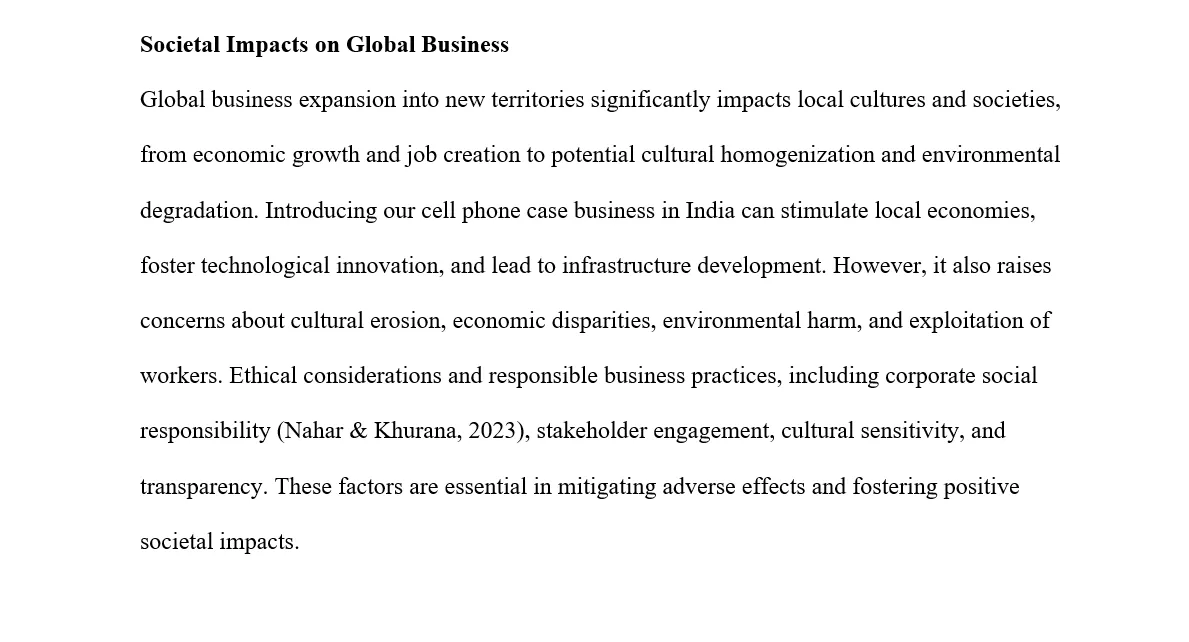
Explain the importance of researching the culture of a potential global market before market entry and key cultural considerations to explore to inform expansion decisions.
Cultural Considerations For Global Business
Culture in globalization is what this element of INT 2-1 Milestone One is about.n.
· Make the point that cultural intelligence and sensitivity are critical for entry into a market.
· Talks about tools and methods to conduct cultural research, like local partnerships, cultural consultants, and academic studies.
Example

Conclusion for INT 220 2-1 Milestone One
This is a How-To Guide for the simple and descriptive INT 2-1 Milestone One problem solution. Keep in mind that we have to complete the 2-1 Milestone One solution to resolve the INT 5-2 Milestone Two problem. Bear with us, and we will show you how resolving these issues is not even remotely difficult. Good luck 🙂
FAQs
Why is India considered a significant market for global business expansion?
Milestone One, INT 2-1, explains that India has a large, fast growing telecom market and that its people frequently use smartphones, which constitute vast opportunities for sales growth. It is a market for business expansion because it’s big and present in the market..
What are the key strategies for successful business adaptation in India?
To be successful at localizing and adapting, you need product localization, culturally aligned marketing, efficient supply chain management, and hire local talent for market insight.
How can global businesses positively impact societies in new markets like India?
INT 1-2 Milestone One How To Guide offers specific instructions regarding implementing companies and reducing environmental impact and cultural enrichment resulting from the adoption of responsible actions including corporate social accountability, stakeholder participation, and cultural awareness.
Why are cultural considerations important in global business expansion?
It is all about understanding local cultures, being able to communicate effectively, working with market strategy, building brand respect and not making any cultural missteps.
References
Gielens, K., Ma, Y., Namin, A., Sethuraman, R., Smith, R. J., Bachtel, R. C., & Jervis, S. (2021). The Future of Private Labels: Towards a Smart Private Label Strategy. Journal of Retailing, 97(1), 99–115. https://doi.org/10.1016/j.jretai.2020.10.007
Mathapati, A. C., & Vidyavati, D. K. (n.d.). A Review of the Indian Mobile Phone Sector.
Nahar, K., & Khurana, D. D. (2023). Corporate Social Responsibility. Vidhyayana – An International Multidisciplinary Peer-Reviewed E-Journal – ISSN 2454-8596, 8(si6), Article si6.
Naradda Gamage, S. K., Ekanayake, E. M. S., Abeyrathne, G., Prasanna, R., Jayasundara, J., & Rajapakshe, P. S. K. (2020). A Review of Global Challenges and Survival Strategies of Small and Medium Enterprises (SMEs). Economies, 8(4), Article 4. https://doi.org/10.3390/economies8040079
Rüth, R., & Netzer, T. (2020). The key elements of cultural intelligence as a driver for digital leadership success. Leadership, Education, Personality: An Interdisciplinary Journal, 2(1), 3–8. https://doi.org/10.1365/s42681-019-00005-x
Stahl, G. K., & Maznevski, M. L. (2021). Unraveling the effects of cultural diversity in teams: A retrospective of research on multicultural work groups and an agenda for future research. Journal of International Business Studies, 52(1), 4–22. https://doi.org/10.1057/s41267-020-00389-9
Step-by-Step Guide for INT 220 2-2 Assignment: Cultural Comparisons
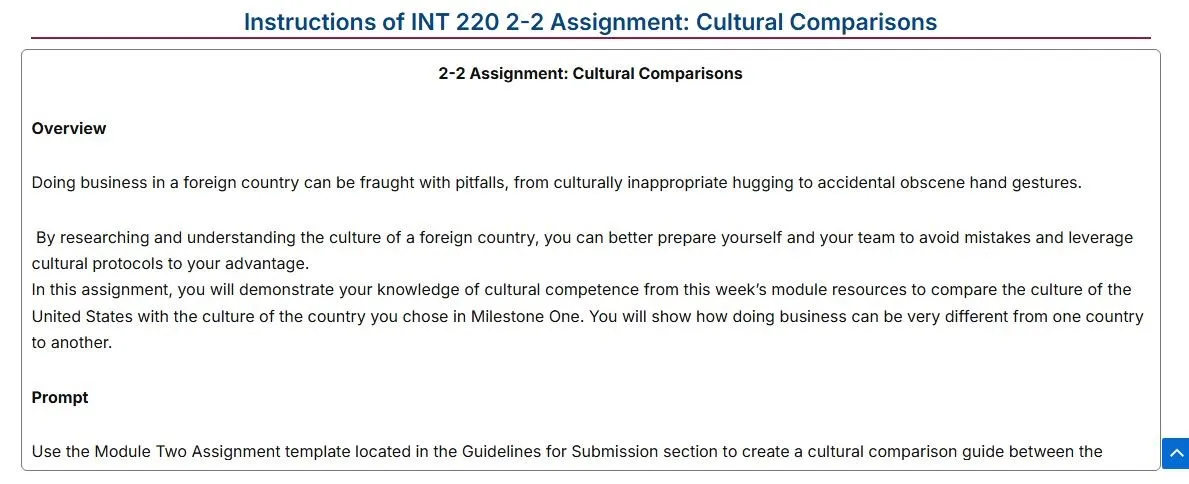
INT 2-1 Milestone One told me to pick India as Country X for my INT 220 Course Project. Thus, we will compare the US with India for INT 2-2 Assignment: Cultural Comparisons. India fits well for Global Dimensions in business and cultural comparisons not only because of its hierarchical respect, structure, collective decision making, and it’s cultural diversity, but also because of its closeness to American markets. You will receive a template similar to the one I am solving for the INT 2-2 Assignment: Cultural Comparisons.
Identify government types, languages, and religions for both countries.Basic Country Facts
To work on this section of the INT 2-2 Assignment, follow the below guidelines:
Example
United States
· Government: Federal republic and constitutional democratic state.
· Language: English.
· Religion: Finally, diverse, but the majority of the population here is Christianity.
India
· Government: Federal parliamentary constitutional republic of.
· Language: Hindi, English.
· Religion: Hinduism , Islam, Christianity, Sikhism
Identify standard business etiquette in both countries (e.g., common greetings, differences in communication toward men and women, negotiating styles, and acceptable business attire).Business Etiquette
The next section of the INT 220 2-2 Assignment: Cultural Comparisons, explains business etiquette.
Example
United States
· Greetings: Firm handshake, eye contact.
· Negotiating Style: Results-oriented.
· Business Attire: It is from business casual to formal.
India
· Greetings: “Universal” (namaste), “English” (hello).
Negotiating Style: Relationship-oriented.
Business Attire: For men, formal suits, and for women, saree or business suit.
Identify three tips you would give individuals doing business in the non-U.S. country you selected. Tips could be about behaviors to avoid (e.g., items as innocent as posture, body language, or attitudes regarding punctuality or approaches to business).
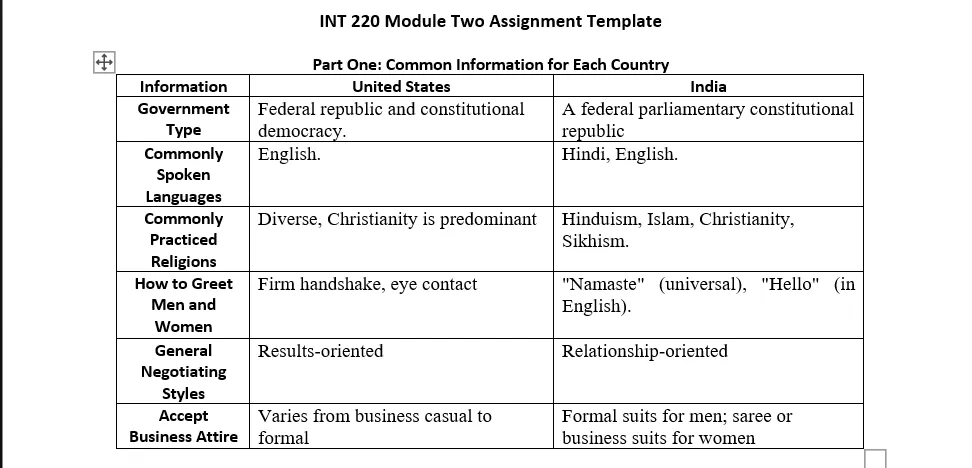
Tips for Doing Business in India
Then we’re going to cover the tips for your business in a chosen country in detail. As I have chosen India for the INT 220 2-2 Assignment: I will offer a solution accordingly to this issue of Cultural Comparison.
· Behavior to avoid or adopt regarding posture or body language: Through cultural awareness training or cultural consulting, guides and monetary, you’d investigate specific non-verbal cues appreciated or frowned upon in India.
· Attitudes towards punctuality: Find out how punctuality is perceived in India. Is he still just passing through his function, or has there changed a more relaxed attitude? One can look up business etiquette books and travel guides.
· Approaches to business meetings or negotiations: Find out which of India’s preferred negotiation styles, meeting formats, and decision-making processes to use. Read business culture consultants and academic articles on international business practices.
Identify and examine the six dimensions in the Hofstede model of national culture for both countries.Cultural Dimensions (Hofstede Model)

In the last section of the 2-2 Global Dimensions of Business Assignment, I will explain dimensions using Hofstede Model.
· Power Distance.
· Individualism vs. Collectivism.
· Masculinity vs. Femininity.
· Uncertainty Avoidance.
· Long-term Orientation vs. Short-term Normative Orientation.
· Indulgence vs. Restraint.
United States
Go to Hofstede’s official website, or to published research, to find the scores for the U.S. and they imply a business culture of American and attitudes of workers.
India
Like with India, Hofstede’s website or academic publications should provide us with of India’s scores. Then discuss what each of the following dimensions would mean for business practices and interpersonal relationships in India.Example

Conclusion
Then conclude what the key takeaways for the 2-2 Assignment.
· Take what has been synthesized to determine what are the major differences and what are the major similarities in business practice between United States and India.
· Make an important point about how to understand and respect these differences to cultivate good international business relations.
· Being cultural competent is ongoing and we should encourage people to grow culturally competent and to grow lifelong learners.Example
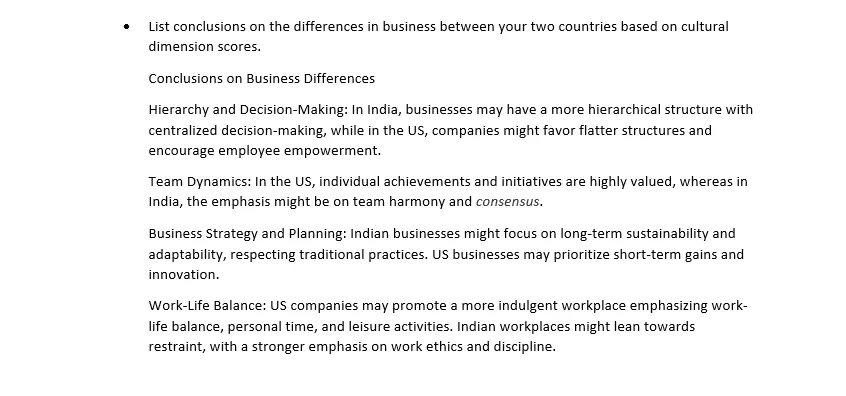
Closing
This How-To INT 220 Guide will equip you with the instructions and guidelines to analyze and differentiate between the US and Indian business environments, allowing you to solve the INT 220 2-2 Assignment: Thoughtfully and effectively done. Cultural Comparisons. I wish you get a good grade on your assignment. Next week in INT 220, we’ll talk about Governmental Trade Interventions.
Reminder:
For upcoming Discussion Posts and Assignments, you may need data from the INT 220 2-2 Assignment: Cultural Comparisons.
FAQs
Why is power distance significant when comparing India and the US?
Attitude towards hierarchy is indicated by power distance. India’s acceptance is different from the US preferring equality and asking questions to authority. For more information, follow the How-To Guide for the INT 220 2-2 Assignment: Cultural Comparisons.How important is punctuality in Indian business culture?
INT 220 2-2 Assignment: The fact is that being on time is appreciated in India, according to Cultural Comparisons. Adaptation to when the site is punctual is beneficial as it has the potential for flexibility surrounding punctuality.
Step-By Step Guide INT 220 3-1 discussion government trade interventions

Introduction to INT 220 3-1 Discussion
The INT 220 3-1 discussion: governmental trade interventions will discuss Governmental Trade Interventions using credible resources and examples.
Overview of why governments intervene in the economy and trade
· Start by researching historical and contemporary reasons governments have intervened in economies and trade.
· Look for resources that explain the goals of such interventions, such as stabilizing economies, protecting industries, encouraging economic growth, or addressing social and environmental concerns.
· Use these insights to explain the rationale behind government interventions in a general sense.
Types of interventions (incentives and restrictions) and their intended
purposes
· Identify and describe the two main types of government interventions: incentives and restrictions.
· Use examples to illustrate how these interventions work and their intended outcomes.
· For instance, incentives may include subsidies or tax breaks to promote specific industries, while restrictions might involve tariffs or regulations to protect domestic markets.
Example
Governments intervene in the economy and trade to stabilize economies, protect industries, encourage growth, and address social and environmental issues. They aim to correct market failures and promote societal welfare. Their tools include incentives like subsidies and tax breaks to stimulate industry growth and restrictions such as tariffs and regulations to protect domestic markets, all designed to achieve policy goals.
Explore how these incentives and restrictions have influenced and can continue to influence trade and the impact of government interventions on business.
Incentives for Businesses
For the next part of the INT 220 3-1 discussion, governmental trade interventions, we will cover the typical incentives that the government provides businesses. Remember to provide examples and cite sources to strengthen your stances.
· Provide a brief description of each type of incentive and discuss how they support businesses.
· Explore how these incentives can attract investment, reduce operational costs, and foster innovation in specific industries.
· Find a recent or significant example of a government incentive in an industry of interest.
· Outline the incentive, the industry affected, and the government’s reasons for the incentive.
Incentives for Businesses
Tax breaks, subsidies, and grants lower business costs, attract investment, and foster innovation, making new ventures and expansion more financially viable.
Example
The U.S. government’s investment in renewable energy includes significant tax credits for solar and wind energy production (Yüksel & Ubay, 2021). This initiative aims to promote clean energy, reduce dependence on fossil fuels, and support environmental sustainability.
Provide an example of government economic intervention designed to influence, regulate, or control trade for a specific industry from one of the articles, and summarize the government’s reasons for the interventions.
Restrictions and Regulatory Measures
For this section of INT 220 3-1 discussion: governmental trade interventions, we will explore the influence of Government Interventions by taking an example.
· Instruct students to research different trade restrictions and regulatory measures governments impose.
· Examine the reasons behind these interventions, such as protecting nascent industries, national security concerns, or environmental protections.
· Find and describe a specific instance of a government-imposed restriction in a sector.
· Discuss the type of restriction, the sector it impacts, and the government’s rationale behind it.
Restrictions and Regulatory Measures
Tariffs, quotas, and regulations protect industries, national security, and environmental safety by controlling market access and enforcing standards.
Example
The U.S. has imposed tariffs on steel imports to protect its domestic steel industry, which bolsters American steel production and secures jobs (Lincicome, 2021)
Impact of Government Interventions on Trade.
Now, we will discuss the impact of Government Interventions on trade.
· Analyze the broader effects of government interventions on global trade patterns.
· Include impacts on trade balances, international relations, and global competitiveness.
· Investigate how trade agreements and economic unions affect government policies on trade interventions.
· Consider the limitations and freedoms these agreements impose on member countries.
Impact of Government Interventions on Trade.
Government incentives boost export competitiveness, while tariffs breed trade disputes, straining international relations. Such interventions sway trade balances, favor domestic goods, or disadvantage foreign ones, altering global trade dynamics. Trade pacts and economic unions ease member trade barriers, fostering standardization and cooperation. They curtail unilateral restrictions, foster economic ties, and bolster collective competitiveness.
Identify which parties and organizations were or will be impacted by the government intervention, including any impacts on the price of commodities.
Effects of Government Interventions on Business
IN INT 220 3-1 discussion: governmental trade interventions, here we will discuss the effects of government interventions on business.
· Explore both the immediate and long-term effects of government interventions on businesses.
· Consider how these policies can alter costs, demand, and market access.
· Identify and analyze strategies businesses can use to adapt to government interventions.
· Include diversifying markets, lobbying for favorable policies, or innovating to meet new standards.
Effects of Government Interventions on Business
Government interventions impact businesses’ costs, demand, and market access with immediate and long-term effects. Policies may raise operational costs or unlock new markets. Businesses adapt via diversification, lobbying for favorable policies, or innovating to comply with regulations, ensuring resilience and sustained growth amid shifting governmental actions.
Briefly summarize critical information a business needs to know from your example to fully understand how the intervention will affect its business.
Conclusion and Recommendations
To summarize the INT 220 3-1 discussion: governmental trade interventions, we will briefly provide critical takeaways from our discussion.
· Summarize the most important lessons learned about government interventions in trade and their impact on businesses.
· Advice on how future business leaders can prepare for and respond to government interventions in their industries.
· Conclude with suggestions on how this knowledge in their future careers, including staying informed on policy changes and developing adaptable business strategies.
Peer Responses
As mentioned and discussed in the INT 220 3-1 discussion: governmental trade interventions, engaging with and answering peers’ queries is essential. Look at the detailed guidelines in the INT 220 1-1 Discussion to deliver professional responses to peers. Do not forget that you have to provide two or more peer responses for the 3-1 Discussion post. I have solved one for reference.
Response 01
Hey Jordan, nice post! It is clear from your post that while the government aims to stabilize the economy and promote societal welfare through interventions like subsidies and tax breaks, these actions often come with unintended consequences (Torres et al., 2024). For instance, the tax credits for renewable energy, intended to decrease reliance on fossil fuels and boost clean energy, also create market distortions that can disadvantage other energy sectors. This highlights the complexity of government interventions where achieving one goal might inadvertently hinder another area, affecting overall market competitiveness and fiscal health (Buiter et al., 2023).
References
Torres, R., Abante, M. V., Cagang, Ma. L., & Vigonte, F. (2024). Taxation Vs. Subsidies: A Comparative Analysis of Government Policies on Elasticity and Economic Indicators. SSRN Electronic Journal.
https://doi.org/10.2139/ssrn.4733494
Buiter, W. H., Cecchetti, S. G., Dominguez, K. M. E., & Sánchez Serrano, A. (2023). Stabilising Financial Markets: Lending and Market Making as a Last Resort (SSRN Scholarly Paper 4338209). https://doi.org/10.2139/ssrn.4338209
Closing
This Owlisdom How-To Guide provides descriptive and easy guidelines for solving INT 220 3-1 discussion: governmental trade interventions. Do not forget to refer to 1-1 Discussion: Global Events and Local Supplies to respond to peers’ questions. I have provided detailed instructions for answering classmates’ queries professionally in INT 220 1-1 Discussion. The next module of INT-220 is about Economic and Political Environments Comparison.
References
Bortz, P. G., Michelena, G., & Toledo, F. (2020). A Gathering of Storms: The Impact of the COVID-19 Pandemic on the Balance of Payments of Emerging Markets and Developing Economies (EMDEs). International Journal of Political Economy, 49(4), 318–335. https://doi.org/10.1080/08911916.2020.1857586
Lincicome, S. (2021). Manufactured Crisis: “Deindustrialization,” Free Markets, and National Security. Cato Institute. https://www.jstor.org/stable/resrep28730
Yüksel, S., & Ubay, G. G. (2021). Determination of Optimal Financial Government Incentives in Wind Energy Investments. In H. Dinçer & S. Yüksel (Eds.), Strategic Outlook in Business and Finance Innovation: Multidimensional Policies for Emerging Economies (pp. 25–34). Emerald Publishing Limited. https://doi.org/10.1108/978-1-80043-444-820211003
Step-By Step Guide INT 220 3-2 assignment: economic and political environments comparison

Introduction to INT 220 3-2 Assignment
In the INT 220 3-2 assignment: economic and political environments comparison, you will function as an international trade consultant tasked with evaluating potential new markets for a selected product. Through the collection and analysis of key economic and political data, you will rank various international markets based on their suitability. This Owlisdom How-To Guide will enhance your understanding of the complexities involved in international market selection and equip you with practical skills in data-driven decision-making.
Application of Data: Describe your initial thoughts on how insights from the required data to be collected could help to inform business decisions. For example, consider what information each data point provides, whether you think some data points should be weighted more heavily than others in making a business decision, what ideal data points might look like for expansion into a new market for your product, the ways that different political systems may impact a decision, and so forth.
Application of Data
To start the INT 220 3-2 assignment, economic and political environments comparison, we will discuss our understanding of the required information for this assignment.
· Understanding the Importance of Data: Reflect on how data serves as the backbone of strategic business decisions. Consider how each piece of data contributes to a broader understanding of market dynamics.
· Data Points for Market Expansion: Identify which data points are critical for assessing market potential. These may include GDP growth rate, consumer spending habits, and market size. Think about the specific characteristics of your product that align with these data points.
· Weighting of Data Points: Discuss the significance of giving certain data points more influence over others. For instance, market size might be more critical than the growth rate for a well-established product.
· Political Systems and Business Decisions: Explore how different governance structures can affect market entry strategies. Consider factors like trade policies, regulatory environment, and political stability.
Example

Political and Economic Data Collection
Complete the table in the provided template by finding the appropriate information and data points for each identified category using the course and external resources.
Political and Economic Data Collection
In INT 220 3-2 assignment: economic and political environments comparison. Next, we will explain the Political and Economic Data Collection by filling out the table given in the template.
· Sources for Data Collection: Utilize a combination of course materials, reputable economic databases (like the World Bank and IMF), and market research reports to gather accurate data.
· Using the Provided Template: Accurately fill in the template provided
in the assignment with the data collected. Ensure current and relevant data
support each category.

Ranking and Rationale
Rank the appropriateness of introducing your selected product into the three markets from “most appropriate” to “least appropriate” using the gathered political and economic data you collected, then provide a rationale for why you ranked the markets the way you did based on the data you gathered.
Ranking and Rationale
For the last section of the INT 220 3-2 assignment, which compares economic and political environments, we will discuss the ranking and rationale of the chosen product.
· Decision-Making Process: Explain your method for ranking the markets. This should logically follow from the data analysis conducted in the previous steps.
· Rationale for Market Ranking: Provide a detailed justification for each ranking position, linking back to specific data points and how they meet the needs and opportunities of your selected product.
Example
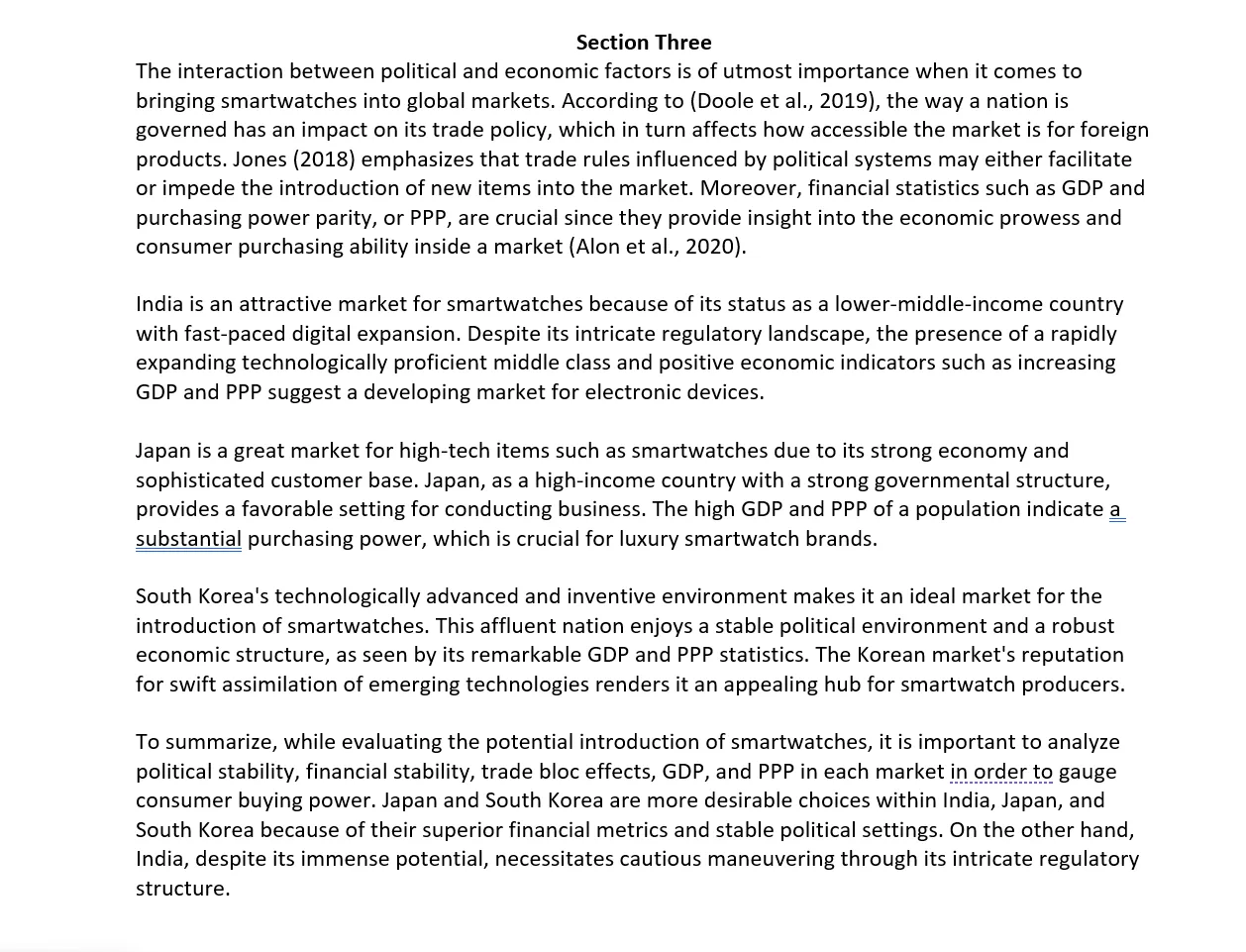
Closing
By following this How-To Guide and addressing each section thoughtfully, you will complete the INT 220 Module Three assignment template, economic and political environments comparison. This guide will help you gain valuable insights into the process of international market selection.
References
Alon, I., Jaffe, E., Prange, C., & Vianelli, D. (2020). Global marketing: Strategy, practice, and cases. Routledge.
Central Intelligence Agency. (2023). Governance & Administration| National Portal of India. https://www.india.gov.in/topics/governance-administration
Doole, I., Lowe, R., & Kenyon, A. (2019). International marketing strategy: Analysis, development, and implementation. Cengage Learning.
Global Edge. (2024). South Korea: Government. https://globaledge.msu.edu/countries/south-korea/government
Jones, A. (2018). Geographies of production III: Economic geographies of management and international business. Progress in Human Geography, 42(2), 275–285.
McElwain, K. M. (2020). The Japanese constitution. In The Oxford Handbook of Japanese Politics.
INT 220 4-1 Discussion: The International Monetary Fund – Step-by-Step Guide
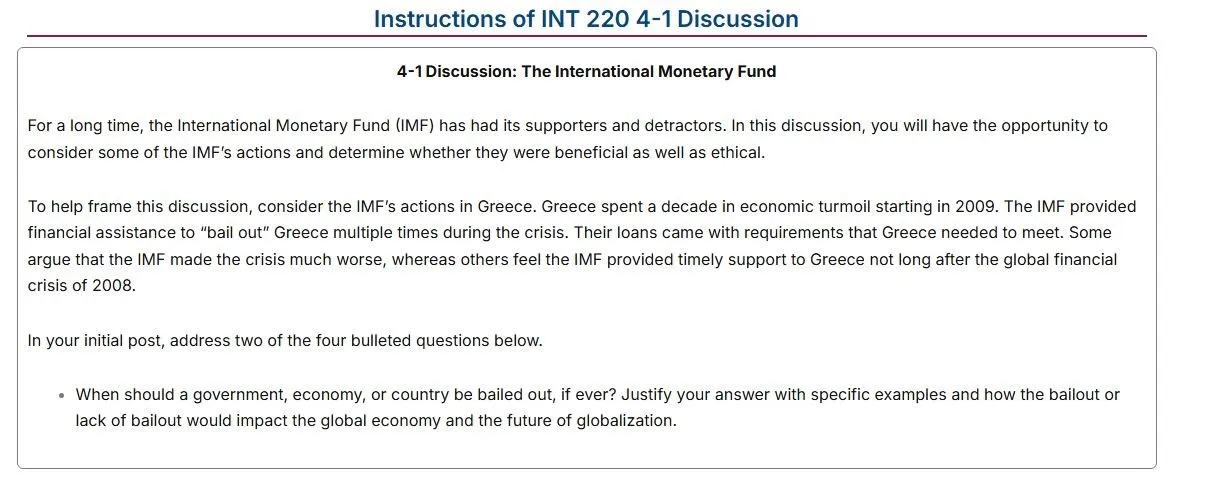
Our Owlisdom Step-By-Step guide of INT 220 4-1 Discussion: The International Monetary Fund, in which we will discuss our understanding of the International Monetary Fund. We will begin by understanding the IMF’s foundational goals to ensure the stability of the international monetary system, facilitate international trade, promote high employment and sustainable economic growth, and reduce poverty around the world. This discussion will explore the IMF’s mechanisms, such as surveillance and financial and technical assistance.
Note: We are asked to answer two of four questions in the INT 220 4-1 Discussion: The International Monetary Fund Instructions. Later on, I will give directions and simulated solutions to all four questions. Still, what is provided in the sample solution will consider only the first two questions. You can take help from those dummy solutions to give solutions for the questions you decide to solve.
Example
The International Monetary Fund is an international organisation that was established with the mandate of fostering global monetary cooperation, exchange rate management and selling international economic growth (Mussa & Savastano, 1999). It offers credit facilities to member countries with balance of payments deficit. There is a policy advice which contributes to stabilizing economies making IMS important to stability of the world economy.
When should a government, economy, or country be bailed out? Justify your answer with specific examples and how the bailout or lack of bailout would impact the global economy and the future of globalization.
Criteria for Bailouts: In this segment of the INT 220 4-1 Discussion: For example, we will examine the criteria and the impacts of the IMF bailout.
· When should a government or country get bailed out?
· Think about how severe the financial crisis is; how risky it is to be contagious to the global economy; and what the associated social impacts with a bailout and absence of it.
· Use historical examples like the Greek debt crisis, or famous worldwide examples of financial events that happened before.
Example
When a government or country’s economic instability threatens its economy and the global economy, it should be in a position to offer a bailout. But only when contagion and economic disruptions for a larger segment are imminent. During the 2009 Greek debt crisis, for example, the international community, along with institutions such as the IMF, provided bailouts to stabilise Greece’s economy, so that it wouldn’t spread to the rest of the Eurozone (Alogoskoufis 2021). The potential default of Greece was of great importance because Greece’s default could have severe repercussions in the interconnected global market and could lead to a cascading failure similar to the failures observed in the 2008 financial crisis (Taskinsoy, 2022). Despite the obvious contentiousness of it, the bailout itself was an important stabilizer within the global economic system because it sought to alleviate these risks, with the bailouts’ stringent fiscal reforms to restore fiscal stability and confidence, like the bailout itself. Such a process emphasizes sign-posting of when bailouts are a necessity (severe financial distress with global reach) and when they are necessary for keeping the global economy booming and globalization going.
Ideally, which countries or organizations would provide the economic support for a government that needs a bailout? Is the IMF the ideal organization to bail out a country?
IDEAL PROVIDERS OF ECONOMIC SUPPORT
Next, we will discuss the ideal Economic Support providers for a government seeking bailout in INT 220 4-1 Discussion: The IMF.
· Let’s evaluate who should provide economic support in times of crisis.
· Now compare the organization to world powers, other international financial institutions like the World Bank, or consortia of countries.
· Talk about the good sides and the dangers, but emphasize whether it will be effective, be geopolitically resonant, and financially stable.
Example
When the economy is in crisis, the International Monetary Fund (IMF) often steps in, exercising the clout available to it as an international membership organization and with a mandate on economic stability (Breen & Doak, 2023). But strict IMF reform rules can spark large-scale social unrest in the borrowing nations. Individual world powers and consortia of countries could offer alternative forms of financial aid, either in the form of financial support alone or with diplomatic or strategic benefits not usually found in IMF programs. But such support could have geopolitical accents, bringing in political expectations that would impact the sovereignty of the recipient. The fact that regional groups such as the European Union can mobilize large amounts of individual resources (potentially with more political strings attached) owing to their collective nature could create more sustainable recovery programs that are more responsive to regional dynamics (Ferrera et al., 2023). But coordination among member states is not without strife, making such multilateral aid efforts not guaranteed or potent enough, sometimes. The key provider, the IMF, remains key due to experience and its systematic approach, but determining this ought to be done strategically by determining what requirements the crisis-affected country requires from aid and potential geographical politics and the flexibility of aid terms (Avakian & Fotaki, 2024). This balance must hold so that the support meets immediate financial needs at the same time as increasing long-term economic stability and growth.
Is it ethical for the IMF to bail out countries that repeatedly make bad economic and fiscal decisions? Is it ethical for the IMF to attach significant requirements to its loans?
Ethical Considerations of IMF Bailouts
In this section of INT 220 4-1 Discussion: We will explore the ethical considerations for bailouts with the International Monetary fund.
· Think about whether under this situation is it ethical for the sum of countries with a bad history in Union economy saved by IMF, and whether the stringent terms connected to the grant of IMF loans are ethical.
· Examine the dichotomy between fiscal discipline that is necessary, however, and that of national sovereignty.
Ethical Considerations of IMF Bailouts
If it is bailed out, the International Monetary Fund (IMF) should bail out countries that have failed consistently to make wise economic and fiscal decisions (Breen & Doak, 2023). First, and perhaps most obviously, these bailouts are essential to avoid global economic meltdown and to spare citizens of the affected countries from devastating damage to their economic welfare. At the same time, repeated bailouts give rise to moral hazards, since public fiscs may adopt lax policies if the international community will easily rescue them from financial mismanagement.
In addition, IMF loans often come with too strict a parameters and this probably causes ethical issues on the impact on national sovereignty. However, the conditions are assumed to ensure that the loan flows would support sustainable economic recovery and not just a bandtaid, and can produce huge changes to national policies. Such could include austerity measures which, in turn, would make the country more poorer and unequal. Consequently, the enforcement of difficult conditions may be considered requisite to instill fiscal restraint and responsibility, while restraint must be sympathetic of a country’s discretion to adopt economic policies. These action have an ethical justification of forging a fair balance between maintaining discipline and retaining the sovereignty of a country whereby any emergent hardship impeded by the imposition of these conditions is received momentarily with long term gains outweighing that.
What lessons should be learned from the Greek debt crisis for countries with debt obligation issues and organizations like the IMF?
Lessons From The Greek Debt Crisis
In this section of the INT 220 4-1 Discussion, we will review the main points covered in The Greek Debt Crisis, all made by the International Monetary Fund.
· Find critical lessons from the Greek debt crisis for other countries in similar debt situations, and organizations like the IMF.
· Look to reforms to policy, to debt management, and to preventive measures to prevent severe economic downturns.
The Greek Debt Crisis
On the eve of writing this, the Greek debt crisis provides critical lessons
for countries that have a large debt obligation and for which the
International Monetary Fund developed its current structure (Avakian &
Fotaki, 2024). The crisis sharpens the need for countries to adopt sustainable
debt management strategies and to further develop proactive fiscal policies.
Preventing a build-up of unsustainable debt depends upon maintaining fiscal
discipline-come down realistic targets for the budget, and effective tax
collection systems. But the crisis has also underscored for the IMF and other
organizations the value of early intervention and the need for bailout
programs that don’t just impose austerity, which can drive deeper recessions
and social revolt. These programs, however, should also support economic
growth and structural reforms that address the reasons for the debt crisis.
This approach could help make sure that financial help provided by the likes
of the IMF stabilizes economies in the short run and lays the foundation for
meaningful long-run economic growth. Moreover, these experiences underscore
that governments that are indebted need to display openness and transparent
communication among themselves and international lenders to foster mutual
trust and cooperation.
Future of Global Currency: Digital Currency Debate
Next, we will explore the future of global currencies in INT 220 4-1 Discussion: The IMF.
· Think about the IMF creating a digital currency.
· Discuss the advisability of the IMF, in contrast to other parties such as global banks or nations, for establishing a global cryptocurrency.
· The ethical problems in adopting a global digital currency should be addressed.
Example
Efficiency and financial inclusion are purported but can bring with it privacy concerns, security and monetary sovereignty. There is an ethical cost to cryptocurrencies made up of market manipulation, illicit purpose, and the environmental toll from energy intensive mining operations.
Conclusion
In conclusion of our INT 220 4-1 discussion, we shall give a brief of what we have received as the most crucial information.
· Finally, reestablish the IMF’s function in global economics, the issues regarding state rescues, and the moral issues that arise.
· Consider how these dynamics will facilitate future policies and the overall international economy.
Example
The IMF’s role in shaping the global economy involves stabilizing economies, providing financial assistance, and promoting policy reforms. Future international monetary policies aim for resilience, inclusivity, and sustainable growth amidst evolving economic landscapes.
The IMF is considering creating a digital currency, and assuming that we are in a world with a single digital currency, who would ideally create a global cryptocurrency? Would you trust the IMF to create one? Or would you prefer one created by a global bank such as JPMorgan Chase or one backed by a country? What are the ethical implications of cryptocurrency?
Peer Responses
INT 220 weekly discussion posts consists of responding to peers as one of the crucial sections. We will have to submit at least two peer responses. I will post one example post. It is possible to write your peer responses following the points listed below.
Response 01
Hey Taylor, great post! As for the question of who should ideally create a global cryptocurrency, the IMF may well fit the bill, as this organization's core business is international monetary cooperation and financial stability. Isolating the IMF as the world’s supervisor in international money, trusting it with the manipulation of a global digital currency may coincide with its aims of maintaining balance and fostering stability in the process of economic growth (Breen & Doak, 2023). However, there is a huge ethical question whether such a currency should be created at all. Concerns such as privacy and security, as well as the risk of reinforcing inequality in economic terms, must be taken into account (Baddam et al., 2023). It also shows some of the main risks that are crucial to address before investing in the new global financial initiative, including, for instance, market manipulation and environmentally unfriendly mining.
Reference
Breen, M., & Doak, E. (2023). The IMF as a global
monitor: Surveillance, information, and financial markets. Review of
International Political Economy, 30(1), 307–331.
https://doi.org/10.1080/09692290.2021.2004441
Baddam, P. R., Yerram, S., Varghese, A., Ande, J. R. P. K., Goda, D. R., & Mallipeddi, S. R. (2023). From Cashless Transactions to Cryptocurrencies: Assessing the Impact of Digitalization on Financial Security. Asian Accounting and Auditing Advancement, 14, 31–42.ClosingBy following the above guidelines, I am sure you will smash the 4-1 Discussion as a maestro would. Good luck
Reference
Alogoskoufis, G. (2021). Greece Before and After the Euro: Macroeconomics, Politics and the Quest for Reforms. SSRN Electronic Journal. https://doi.org/10.2139/ssrn.3801659
Avakian, S., & Fotaki, M. (2024). Accounting for Failure Through Morality: The IMF’s Involvement in (Mis) Managing the Greek Crisis. Journal of Business Ethics, 189(4), 817–841. https://doi.org/10.1007/s10551-022-05312-w
Baddam, P. R., Yerram, S., Varghese, A., Ande, J. R. P. K., Goda, D. R., & Mallipeddi, S. R. (2023). From Cashless Transactions to Cryptocurrencies: Assessing the Impact of Digitalization on Financial Security. Asian Accounting and Auditing Advancement, 14, 31–42.
Breen, M., & Doak, E. (2023). The IMF as a global monitor: Surveillance, information, and financial markets. Review of International Political Economy, 30(1), 307–331. https://doi.org/10.1080/09692290.2021.2004441
Ferrera, M., Corti, F., & Keune, M. (2023). Social citizenship as a marble cake: The changing pattern of right production and the role of the EU. Journal of European Social Policy, 33(5), 493–509. https://doi.org/10.1177/09589287231207333
Mussa, M., & Savastano, M. (1999). The IMF Approach to Economic Stabilization. NBER Macroeconomics Annual, 14, 79–122. https://doi.org/10.1086/654380
Taskinsoy, J. (2022). Financial Crises Continue to Strike Amid Accelerated Evolution of Risk Management (SSRN Scholarly Paper 4038732). https://doi.org/10.2139/ssrn.4038732
Step-By-Step Guide of INT 220 4-2 assignment: Foreign Exchange

Introduction to INT 220 4-2 Assignment
In INT 220 4-2 assignment: foreign exchange, we are instructed to write a short business memo to analyze the impact of foreign exchange. That explains the profitability, viability, and importance of considering foreign exchange based on the scenarios provided in the INT 220 4-2 assignment on foreign exchange. You will add the points explained in the memo.
Determine the profitability of the international business by using foreign exchange calculations for the first and second scenarios.
Scenario Analysis
In the first section of the 4-2 assignment on foreign exchange, we will discuss the profitability of International Businesses.
· Briefly introduce the concept of foreign exchange and its importance to international business operations, especially for manufacturing companies dealing with transactions in foreign currencies.
· Understand the intricacies of foreign exchange (FX).
· Demystify the impact of FX movements on our operations by focusing on transactions with Malaysia.
· Scenario 1: “The company uses the spot rate on April 1st to convert its sales revenue in MYR to U.S. dollars.”
· Scenario 2: “On January 1st, the company uses that day’s forward rate today to lock in a foreign exchange rate for its expected 1.25 million MYR in sales.”
· Scenario 3: The company considers using foreign currency directly to purchase raw materials to avoid currency exchange risk.
Foreign Exchange Calculations
To assess profitability, let’s dive into the math for Scenarios 1 and 2:
· For Scenario 1, we use the April 1st spot rate of 3.52 MYR to convert our sales revenue back to U.S. dollars.
· In Scenario 2, we lock in the forward rate of 0.317 U.S. dollars/MYR as of January 1st for our April sales.
Foreign Exchange Calculations
Scenario 1: Using the April 1st spot rate of 3.52 MYR to convert sales revenue back to U.S. dollars, we calculate:
1.25 million MYR / 3.52 MYR per USD = $354,545.45 USD.
Scenario 2: Locking in the forward rate of 0.317 USD/MYR as of January 1st for April sales, the revenue conversion is:
1.25 million MYR * 0.317 USD/MYR = $396,250 USD.
Discuss what you must consider when determining whether the company should buy raw materials with foreign currency to avoid foreign exchange risk and whether this option is viable.
Spend or Save
When pondering whether to spend the foreign currency on raw materials or save it, consider:
· The current and expected exchange rates.
· The cost and availability of raw materials are needed.
· The potential savings or costs associated with avoiding foreign exchange risks.
Conclusion
Ultimately, we will provide the key findings of the INT 220 4-2 assignment: foreign exchange.
· A proactive approach to managing FX risk—not just through hedging strategies like forward contracts but also operational decisions like using foreign currency earnings to purchase raw materials—can safeguard our profitability.
· Currency fluctuation underscores the importance of integrating FX risk management into our financial planning and decision-making processes.
· Navigate the complex world of international business and ensure your company’s financial health against an ever-evolving global economic landscape.
Closing
This Owlisdom How-To INT 220 Guide provides all the required information and guidance for writing the business memo required in the INT 220 4-2 assignment: foreign exchange. Calculate the conversion numerically according to your assignment’s data and exchange rates. Good luck
FAQs
1. How did foreign exchange rates affect our Q1 profitability in Malaysia?
Unfavorable rates led to a loss in Scenario 1, while locking in a forward rate in Scenario 2 resulted in profit. Refer to the 4-2 Assignment: Foreign Exchange for details.
2. Can spending foreign currency on raw materials reduce exchange risk?
This approach can mitigate exchange risk, but it requires an analysis of material needs and price advantages. INT 220 4-2 Assignment provides further insight.
Step-By-Step Guide of INT 220 5-1 Discussion: Data Privacy Consideration
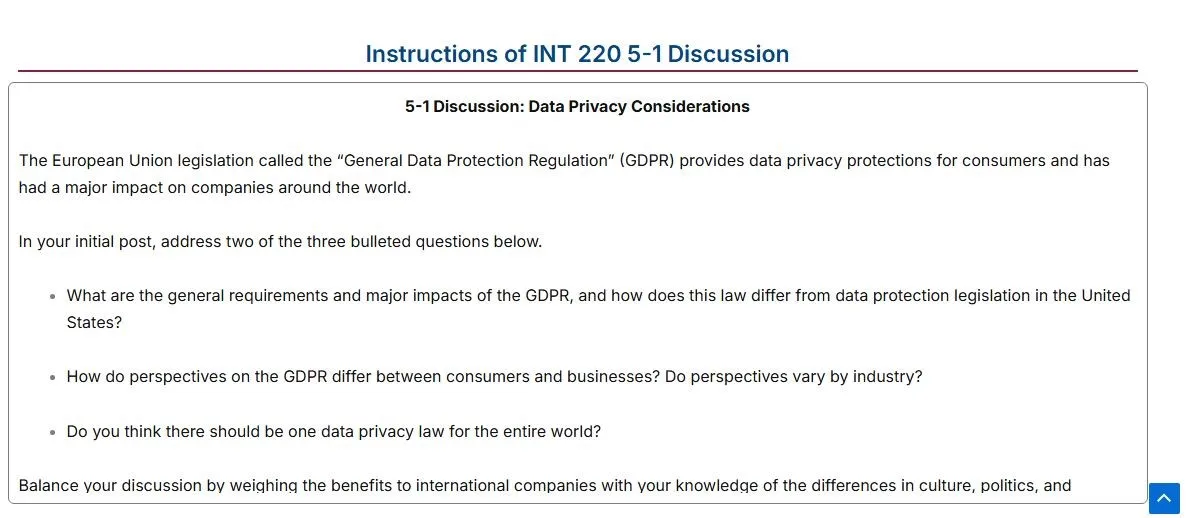
Introduction to INT 220 5-1 Discussion
Understanding and protecting your data privacy is crucial in our digital world. This How-To INT 220 Guide on Owlisdom simplifies this complex topic, offering you the tools and knowledge to work on INT 220 5-1 Discussion: Data Privacy Considerations. Let us get started!
How do perspectives on the GDPR differ between consumers and businesses? Do perspectives vary by industry?
Consumer vs. Business Perspectives on GDPR
In this section of the INT 220 5-1 Discussion: Data Privacy Considerations, we will focus on the different perspectives of consumers and businesses on GDPR.
· Consumers generally welcome GDPR’s stringent protections, valuing enhanced privacy rights and control over personal information.
· Discuss: Businesses often view GDPR as a regulatory burden, citing increased compliance costs and operational complexities.
· Viewpoint across industries, with sectors like tech and finance facing more significant challenges due to their data-centric operations.
· Delving into the differences provides insights into the GDPR’s multifaceted impact.Example
Consumers generally appreciate GDPR’s strict protections, valuing improved privacy and personal data control (Anant et al., n.d.). Conversely, businesses often see GDPR as a regulatory burden due to higher compliance costs and operational challenges(Chander et al., 2021). Perspectives vary across industries, with tech and finance sectors facing more significant hurdles because of their data-driven nature. Understanding these differences offers valuable insights into GDPR’s complex effects on consumers and businesses.
Should there be one data privacy law for the world? The Prospect of a Universal Data Privacy Law
Let us discuss the prospect of universal data privacy. This INT 220 5-1 Discussion: Data Privacy Considerations section is vital to data privacy considerations.
· Explore the tension between the efficiency of a universal data privacy standard and the respect for national sovereignty and cultural differences.
· A single law could simplify compliance for international companies, but might only accommodate some societies’ unique needs and values. Discuss.
· How is balancing these factors crucial for envisioning a globally coherent yet flexible data privacy framework?Example
Balancing a universal data privacy law’s efficiency with respect for national sovereignty and cultural diversity is vital. While a single law could streamline compliance for multinational corporations, it may not address societies’ unique needs and values. Achieving a globally coherent yet flexible data privacy framework requires careful consideration of these factors to ensure effectiveness while respecting diverse cultural and legal contexts.
In your responses to two or more of your peers, address whether you agree or disagree with your peer’s opinion and whether there should be global data privacy legislation.
Engaging with Peers
As mentioned in 1-1 Discussion and 3-1 Discussion, we must craft professional and engaging peer responses. Refer to the 1-1 Discussion post for instructions on how to write peer responses. Keep in mind that you are required to provide two or more responses.
· Effective engagement requires respectful dialogue and open-mindedness.
· Whether agreeing or disagreeing with peers, emphasize constructive criticism and build on their viewpoints.
· Consider the complexity of the global data privacy debate, highlighting the pros and cons of a universal law from various perspectives.
Example
I appreciate the thoughtful insights on the need for global data privacy legislation. While harmonizing data privacy laws can simplify compliance and protect users, the complexity and diversity of international legal systems pose significant challenges. Countries have varied cultural norms and legal frameworks, making a one-size-fits-all approach difficult (Ortega-Argilés, 2022). However, a flexible global framework that sets minimum standards while allowing countries to adapt it to their specific needs could offer a balanced solution. This approach respects local nuances while ensuring privacy protection worldwide, fostering trust and cooperation across borders.
Reference
Ortega-Argilés, R. (2022). The evolution of regional entrepreneurship policies: “No one size fits all.” The Annals of Regional Science, 69(3), 585–610.
https://doi.org/10.1007/s00168-022-01128-8
Conclusion
· Key takeaways.
· Summarize the significant aspects of GDPR and US Data Protection Laws.
Example Conclusion
Key takeaways from the 5-1 Discussion include balancing efficiency with respect for cultural differences in data privacy legislation. While consumers generally appreciate GDPR’s stringent protections, businesses often consider them a regulatory burden. The debate over a universal data privacy law underscores the complexity of accommodating diverse societal needs while ensuring global coherence. Understanding the nuances of GDPR and US data protection laws is crucial for businesses navigating the evolving regulatory landscape while respecting consumer rights and cultural sensitivities. (Nicola & Pollicino, 2020)
Closing
You will surely ace the INT 220 5-1 Discussion: Data Privacy Considerations by considering these guidelines.
Good luck
References
Anant, V., Donchak, L., Kaplan, J., & Soller, H. (n.d.). The consumer-data opportunity and the privacy imperative.
Chander, A., Abraham, M., Chandy, S., Fang, Y., Park, D., & Yu, I. (2021). Achieving Privacy: Costs of Compliance and Enforcement of Data Protection Regulation (SSRN Scholarly Paper 3827228).
https://doi.org/10.2139/ssrn.3827228
Nicola, F. G., & Pollicino, O. (2020). The Balkanization of Data Privacy Regulation. West Virginia Law Review, 123, 61.
Step-By-Step Guide INT 220 5-2 Milestone Two
Step-By-Step Guide INT 220 5-2 Milestone Two
Introduction to INT 220 5-2 Milestone Two
This milestone is connected to INT 220 2-1 Milestone One. As mentioned in previous modules, we have selected India for the INT 220 course project. In this milestone, we will work on global market entry in India and the US by exploring international markets. Also, INT 220 5-2 Milestone Two focuses on the importance of cultural, political, and economic analysis in global expansion.
Compare and contrast critical cultural elements of your selected market against those in the domestic market, including communication, dimensions of culture, attitudes, standard business etiquette and practices, and at least five other vital aspects of culture.
Cultural Profile For this first part of INT 220 5-2 Milestone Two, we need to compare the market profiles of both countries (the US and the country you selected for the project)
Reminder: We have already created a cultural profile for the US
and India in INT 220 2-2. Assignment: Cultural Comparisons. Example
Compare and contrast important political and economic factors for your selected market against those in the domestic market, including political systems and ideologies, curren t leaders, economic measures or characteristics used in classification, and government intervention in trade.

Political and Economic Profile
Let’s delve into the U.S. political system (federal republic, democratic principles), its economic status (advanced, market-based), and how the government influences trade (tariffs, trade agreements). Understand how these elements differ in your selected market.
Example
Compare and contrast essential legal and regulatory requirements of your selected market against those in the domestic market, including trade restrictions, regulations of products or services, legal processes for business transactions, and import restrictions or documentation.
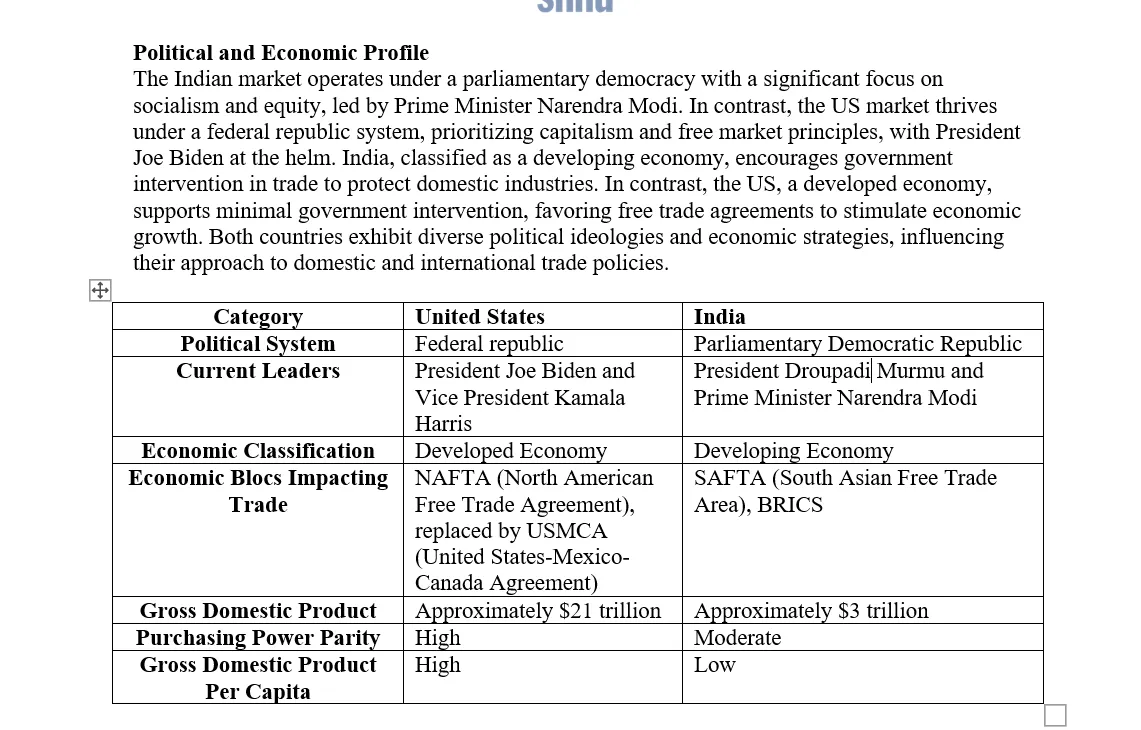
Legal and Regulatory Profile
Now, we will compare the legal and regulatory profiles of both countries.
Outline the U.S. legal framework for businesses, including trade restrictions (sanctions, embargoes), product regulations (safety, compliance standards), and import procedures.
Compare these with your chosen country’s legal landscape, which will highlight potential challenges and opportunities.
Example
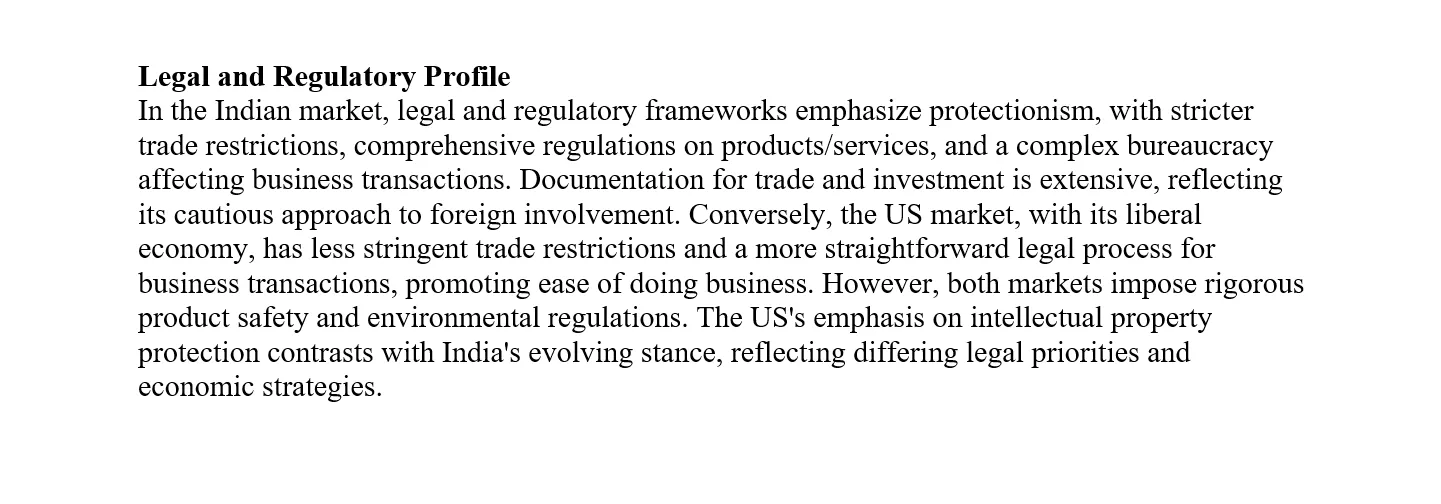
Closing
This Owlisdom How-To Guide provides detailed instructions and a dummy solution along with guidelines. These guidelines help you solve INT 220 5-2 Milestone Two like a pro. Good luck
FAQs
1. What are the leading trade restrictions in the USA and India?
The USA uses tariffs and agreements like USMCA for protection, while India uses tariffs and SAFTA for liberalization.
2. How do product regulations differ between the USA and India?
The USA emphasizes safety and environmental standards across sectors, whereas India focuses on sector-specific standards through bodies like BIS.
Step-By-Step Guide of INT 220 6-1 assignment: international team expectations
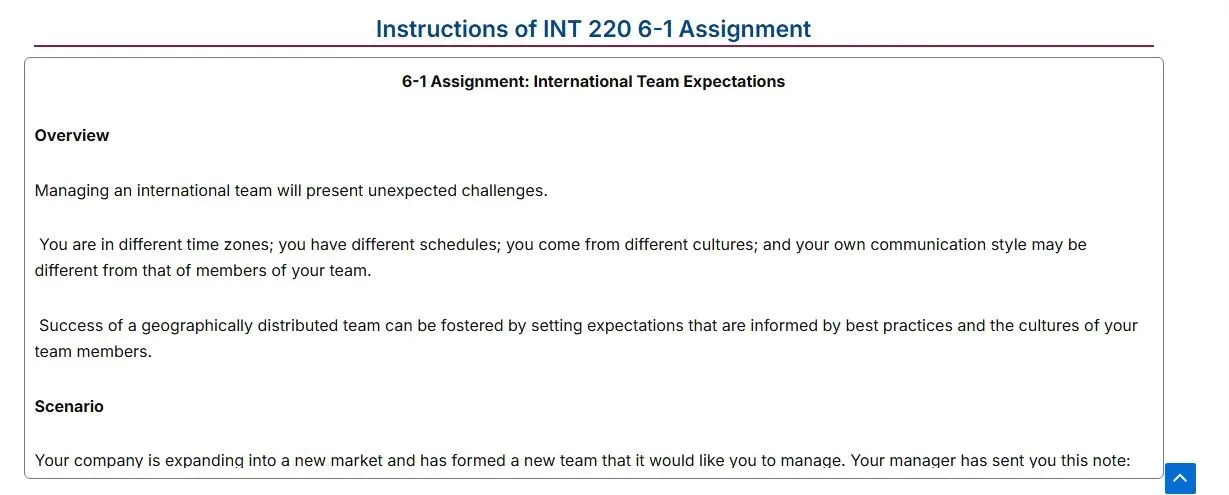
In this assignment, we must email our manager explaining how we plan to manage an international team. The email must be written in an MS Word document, while the next part of the 6-1 Assignment must be filled out using the template given, along with the instructions of INT 220 6-1 assignment: international team expectations. Following the instructions and guidelines in this Owlisdom How-To Guide, you can solve the INT 220 6-1 assignment like a pro. Additionally, we will be scheduling a conference call to introduce the team, discuss roles, and set clear expectations for collaboration, ensuring everyone is aligned with the project goals.
Cultural considerations for each team member
For the first part of the INT 220 6-1 assignment: international team expectations, we will discuss the cultural dynamics of both countries.
· Research and understand the average cultural dimensions of each team member’s country using resources like Hofstede Insights.
· In the INT 220 Module Six Assignment Conference Call Invitation Template, when addressing Kelly from the US, it’s important to focus on individualism, short-term orientation, and low power distance, as these traits influence communication and collaboration styles in the US. Understanding how these cultural aspects affect Kelly’s approach to teamwork will help in fostering better communication and ensuring effective collaboration within the team.
Common issues among diverse or global teams and potential conflicts
Identifying Common Issues and Conflicts in INT 220 6-1 assignment: International Team Expectations
Discuss the common issues managers and team members face due to diverse working environments.
· Address language barriers, time zone differences, and cultural misunderstandings.
· In the INT 220 Module Six Assignment, it is essential to highlight how certain issues can be amplified by the direct communication style prevalent in US culture. The straightforward approach that is common in the United States can sometimes lead to misunderstandings in an international team, especially when interacting with individuals from cultures where communication is more indirect or context-driven. It is crucial to address these potential challenges and adopt strategies to ensure effective cross-cultural communication.
Multiple management approaches you plan to use and why
Management Approaches for Diverse Teams
In this INT 220 6-1 assignment: international team expectations section, we will explore the management approaches of international teams.
· Embrace a flexible leadership style, encourage open communication, and foster a culture of inclusivity.
· Explain how these approaches are practical in navigating the dynamics of the US work culture, which values transparency and equality.
A policy for selecting which holidays team members can take off.
Policy for Cultural Holidays and Time Off
In this segment of the INT 220 6-1 assignment: international team expectations, let’s explore the vast theme of policies for cultural holidays for international teams.
· Develop a flexible holiday policy that respects all cultural backgrounds while considering US national holidays.
· This policy should ensure fairness and promote work-life balance. In the INT 220 Conference Call Invitation, we will also discuss our policy to ensure fairness and promote work-life balance.
A determination of whether your team will collaboratively create team expectations and a communication plan.
Team Expectations and Communication Plan
Let’s explore how to determine international team expectations and communication plans.
· Decide based on the team’s comfort with collaborative decision-making, a common practice in US culture that encourages team engagement and ownership.
Conference Call Invitation
As part of the INT 220 Module 6 assignment, I have filled out the template for “international team expectations” with sample data. I will follow the instructions in the guidelines to fill it out according to the expectations for our team. This will ensure that we have a clear understanding of the roles, responsibilities, and communication expectations for everyone involved.
Example
Closing
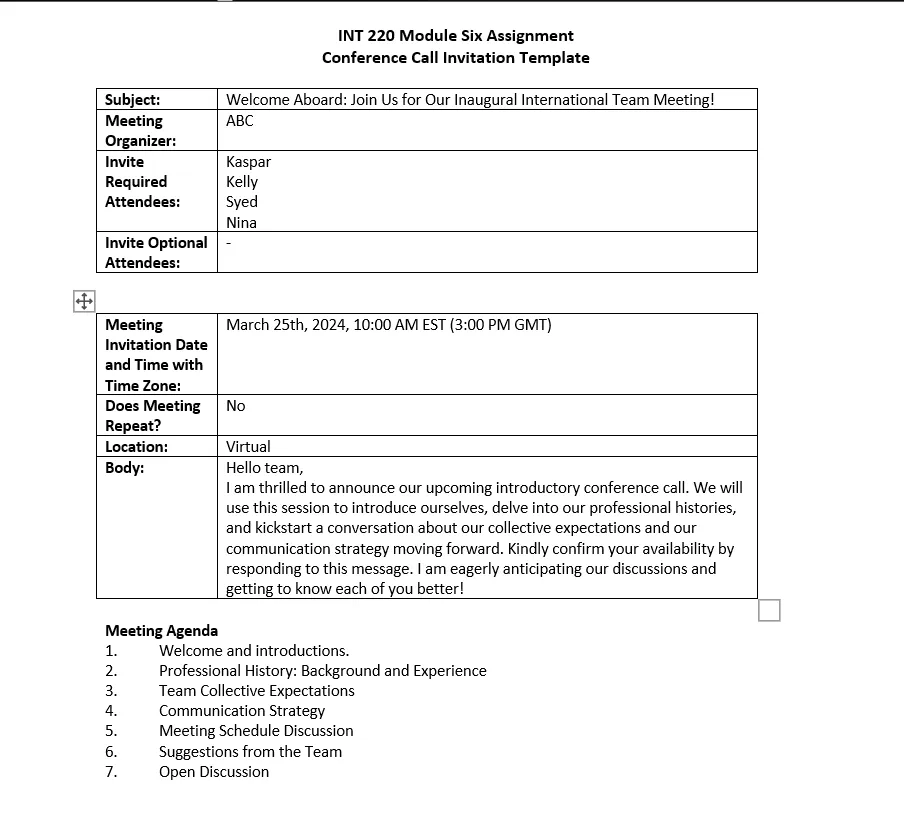
By following the above guidelines, I am sure you will smash the INT 220 6-1 assignment: international team expectations as a maestro would. Good luck
Step-By-Step Guide of INT 220 6-2 assignment: global supply chain case study
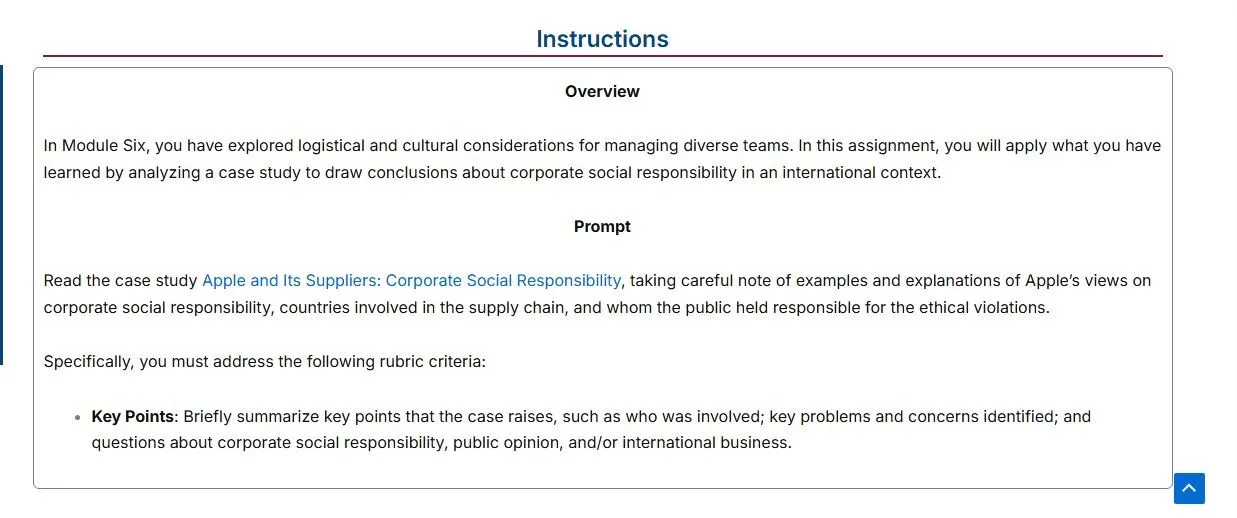
Introduction to INT 220 6-2 Assignment
This Owlisdom How-To Guide is designed to assist you in analyzing the case study “Apple and Its Suppliers: Corporate Social Responsibility.” The INT 220 6-2 assignment: Global Supply Chain Case Study focuses on understanding the complexities of CSR in an international context, particularly how businesses like Apple handle ethical concerns in their supply chains.
Key Points: Briefly summarize key points that the case raises, such as who was involved, key problems and concerns identified, and questions about corporate social responsibility, public opinion, and international business.
Key Points Analysis
To start the INT 220 6-2 assignment: global supply chain case study, we will briefly summarize the key issues presented in the case.
· Identify the main stakeholders involved, including Apple and its suppliers like Foxconn and Pegatron.
· Outline the primary ethical concerns raised and how they relate to CSR.
· Note any significant questions about public opinion and international business practices that the case presents.ExampleIn the case of Apple and its suppliers, several critical issues surface regarding ethical practices within global supply chains. Stakeholders primarily include Apple itself and its significant suppliers like Foxconn and Pegatron (Ma, 2020). These entities face severe criticisms related to the exploitation of workers through unacceptable labor conditions, including excessively long working hours and poor wages. The dilemma extends into the broader implications for corporate social responsibility, highlighting the global repercussions of localized unethical practices.
Corporate Social Responsibility: Explain how corporate social responsibility, specifically related to employee treatment, is important to a business.
Understanding Corporate Social Responsibility (CSR)
In INT 220 6-2, the assignment is a global supply chain case study. Next, we will discuss the importance of CSR in business, focusing on employee treatment.
· Define CSR and its relevance to business success.
· Explain how ethical treatment of employees can enhance a company’s reputation and contribute to its long-term sustainability.
· Use examples from the case to illustrate Apple’s approach to CSR.
Example
In the case of Apple and its suppliers, several critical issues surface regarding ethical practices within global supply chains. Stakeholders primarily include Apple itself and its significant suppliers like Foxconn and Pegatron (Ma, 2020). These entities face severe criticisms related to the exploitation of workers through unacceptable labor conditions, including excessively long working hours and poor wages. The dilemma extends into the broader implications for corporate social responsibility, highlighting the global repercussions of localized unethical practices.
Understanding Corporate Social Responsibility (CSR)
In INT 220 6-2, the assignment is a global supply chain case study. Next, we will discuss the importance of CSR in business, focusing on employee treatment.
- Define CSR and its relevance to business success.
- Explain how ethical treatment of employees can enhance a company’s reputation and contribute to its long-term sustainability.
- Use examples from the case to illustrate Apple’s approach to CSR.
Impact of Public Opinion and Media
For this section of the INT-220 6-2 assignment: global supply chain case study, we will analyze the role of media and public perception in shaping business practices.
· Describe how the media coverage of Apple’s supplier practices influenced public opinion.
· Discuss the consequences of this public perception for Apple.
· Extract lessons that business professionals can learn about managing public relations and media influence.
Example
The Apple case exemplifies the profound impact of public opinion and media on corporate behavior. Media reports on poor labor practices within Apple’s supply chain dramatically altered public perception and underscored the media’s role in promoting corporate accountability (Nardella et al., 2023). This scenario emphasizes the interaction between media scrutiny and corporate action, showing how negative publicity prompted Apple to implement reforms. It is crucial to highlight the importance of maintaining open communication with the public and adopting transparent practices. Such measures can prevent negative exposure and enhance brand resilience, ensuring the company can withstand scrutiny while building trust. Ultimately, a proactive approach to media relations and transparency is vital for sustaining a positive corporate image.
International Business: The case states that although the concerns regarding poor employee treatment were related to events at manufacturing facilities such as Foxconn and Pegatron, the concerns regarding corporate social responsibility fell to Apple. Explain what this can teach business professionals about international business and supply chain management.
Insights into International Business and Supply Chain Management
Now, in INT 220 6-2 assignment: global supply chain case study, we will explain the implications of the case for international business operations.
· Detail how global supply chain issues can reflect on a company’s reputation and CSR policies.
· Discuss the specific challenges faced by Apple in managing international suppliers and the broader lessons applicable to global business management.
Example
Analyzing the international business operations of Apple, it is crucial to understand the ramifications of corporate social responsibility (CSR) issues on the company’s global reputation. Apple’s challenges illustrate that CSR concerns in even remote parts of the supply chain can significantly affect the company’s core operations and public image (Liu et al., 2020). It is essential to implement robust oversight mechanisms to ensure that all parts of the supply chain adhere to ethical standards. Failure to do so can result in severe damage to the company’s reputation. Therefore, companies must adopt proactive engagement and stringent compliance checks within their supply chains to prevent ethical breaches and safeguard their global operations.
Labor Practices: Compare the advantages and disadvantages of commonly used labor practices in international business.
Evaluating Labor Practices
For this INT 220 6-2 assignment: global supply chain case study segment, we will compare the pros and cons of various labor practices.
· List common labor practices in international business, citing examples from the case.
· Analyze the advantages and disadvantages of these practices concerning ethics, efficiency, and CSR.
Example
Exploring labor practices in Apple’s supply chains highlights a balance between cost-efficiency and ethical standards. Outsourcing to regions with lower labor costs offers significant economic benefits but also raises ethical concerns. The evaluation of these practices involves weighing the financial advantages against the potential for ethical violations. A balanced approach is necessary, considering both business needs and moral responsibilities. Companies must ensure that cost savings do not compromise ethical integrity (Chukwu et al., 2023). Adopting fair labor practices maintains a company’s reputation, fostering long-term sustainability in the global marketplace.
The Road Ahead: The end of the case raises a few questions regarding how Apple should proceed. Based on what you have learned in this module and throughout the course, explain how you think Apple should have proceeded following the incident outlined in the case and why. Make sure to use evidence from the course and external resources to support your response.
Future Recommendations for Apple
The next section of the INT 220 6-2 assignment, the global supply chain case study, revolves around suggesting ways Apple could improve or modify its strategies post-incident.
· Based on the analysis and the course content, recommend strategies for Apple moving forward.
· Justify your recommendations with evidence from the case or external resources, focusing on enhancing CSR and addressing public concerns.
Example
Based on the analysis of Apple’s CSR practices and the reactions from the public and media, it is recommended that Apple intensify its monitoring and rectification of labor practices within its supply chain. Implementing more stringent compliance standards and enhancing transparency are crucial steps. Additionally, Apple should engage more directly with stakeholders, including workers and local communities. This engagement will promote inclusivity and enrich its CSR initiatives (Kolk, 2016).
Closing
The INT 220 6-2 assignment: Global Supply Chain Case Study encourages you to critically evaluate how multinational corporations manage CSR, particularly through their international supply chains. By analyzing Apple’s strategies and public response, you can derive valuable insights into effective CSR practices and the crucial role of ethical management in maintaining a company’s reputation. This How-To Guide not only helps in academic understanding but also prepares you for real-world business challenges.
References
Chukwu, E., Adu-Baah, A., Niaz, M., Nwagwu, U., & Chukwu, M. U. (2023). Navigating ethical supply chains: The intersection of diplomatic management and theological ethics. International Journal of Multidisciplinary Sciences and Arts, 2(1), 127–139.
Kaftanov, A. (2024). Sustainability and competition law. Vilniaus universitetas.
Kolk, A. (2016). The social responsibility of international business: From ethics and the environment to CSR and sustainable development. Journal of World Business, 51(1), 23–34.
Liu, X., Mattoo, A., Wang, Z., & Wei, S.-J. (2020). Services development and comparative advantage in manufacturing. Journal of Development Economics, 144, 102438. https://doi.org/10.1016/j.jdeveco.2019.102438
Ma, W. (2020). Apple Took Three Years to Cut Ties With Supplier That Used Underage Labor. The Information.
Nardella, G., Brammer, S., & Surdu, I. (2023). The social regulation of corporate social irresponsibility: Reviewing the contribution of corporate reputation. International Journal of Management Reviews, 25(1), 200–229.
Radzi, N. A. M., Hezbollah, H. R., Normaizatul Akma, S., Hashim, H., & Ali, A. F. M. (2020). Wellness, Work, and Employee Assistance Programs as Part of CSR Initiatives among Corporate Companies.
https://doi.org/10.48080/jae.v17i4.378
Step-By-Step Guide INT 220 7-1 Project Submission

Introduction to INT 220 7-1 Project
Finally! This is the last part of the INT 220 2-1 Milestone One and INT 220 5-2 Milestone Two. We must solve this part and combine all three milestones to form the final INT 220 7-1 PROJECT SUBMISSION. This Owlisdom guide will help you understand the process and considerations in expanding a cell phone case business to the Indian market. It focuses on market considerations, monetary factors, management and logistics, and entry mode. The instructions provided are based on the original task instructions, which focused on India as the selected market.
Explain the similarities, differences, and considerations for conducting business between the two markets, such as general legal and regulatory requirements, monetary and management logistics, and mode-of-entry considerations.
Market Considerations
Let’s compare and contrast essential market considerations for your selected market against those in the domestic market.
Similarities and Differences
Analyze market size and consumer preferences in both the U.S. and India. Highlight the importance of understanding local tastes, pricing sensitivity, and brand recognition.
Legal and Regulatory Requirements
Investigate India’s specific requirements for business registration, import regulations, and consumer protection. Emphasize the need for compliance with local laws to ensure smooth operations.
Monetary and Management Logistics
Examine the impact of currency exchange rates between the USD and INR on pricing and costs. Stress the importance of financial planning and local management adaptations to navigate India’s diverse market and logistical challenges efficiently.
Explain how monetary considerations such as currency, exchange rates, and exchange-rate management would impact the organization’s decision to expand into your selected market, using current exchange rates between your selected country and the United States to support your explanations.
Monetary Considerations
This section of the INT 220 7-1 PROJECT SUBMISSION will discuss the monetary considerations for both countries and their currencies.
Currency and Exchange Rates
Understand the fluctuating exchange rates between the U.S. dollar (USD) and Indian Rupee (INR). Awareness of these rates is crucial for pricing strategies and financial forecasting.
Exchange-Rate Management
Implement financial instruments like forward contracts or options to hedge against exchange rate volatility. This proactive approach helps manage cost predictability and protect profit margins. Students should consult financial experts to choose the best exchange-rate management strategies tailored to their business needs, ensuring stability in the dynamic Indian market environment.
Example
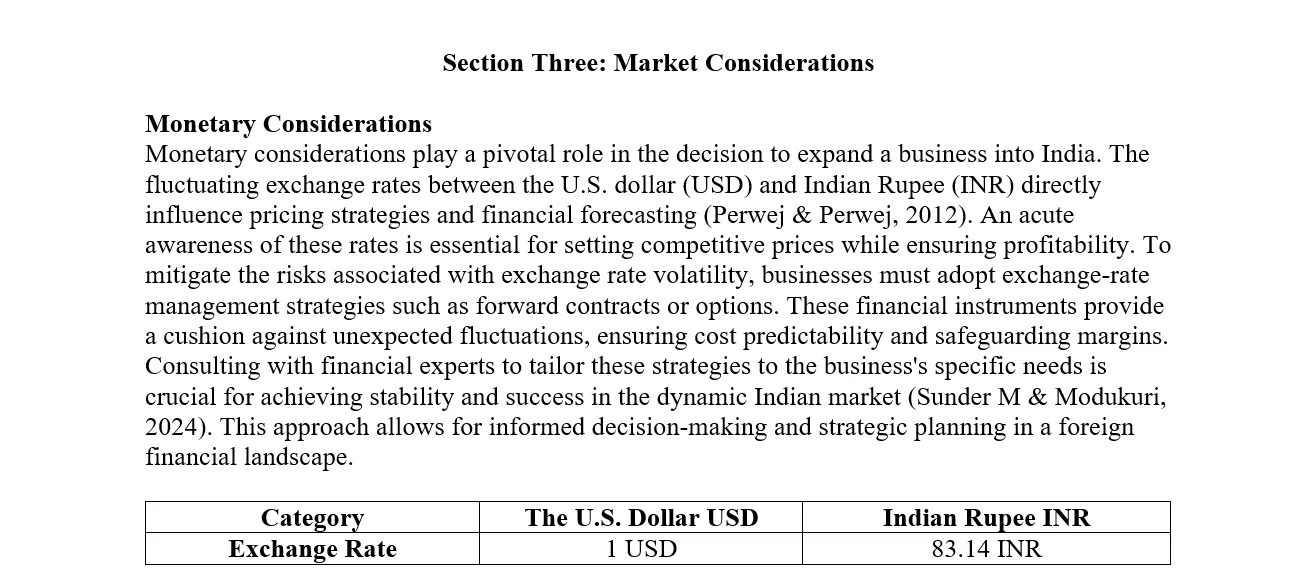
Explain management and logistics practices that best address human-resource considerations for your selected market, such as management approaches or staff and labor laws and their impact on policies and procedures.
Management and Logistics Considerations
We will explain the management and logistics considerations in this INT 220 7-1 Project Submission
Human-Resource Management
Adapt leadership and management practices to align with Indian cultural norms and business etiquette. Prioritizing local hiring can leverage local market understanding and enhance operational efficiency.
Staff and Labor Laws
Familiarize yourself with India’s comprehensive labor laws regarding wages, working conditions, and termination policies. Compliance is non-negotiable for ethical operations and maintaining a positive brand image. Students should seek local legal advice to navigate these regulations effectively and ensure that their business operations are respectful and lawful within the Indian context.
Example
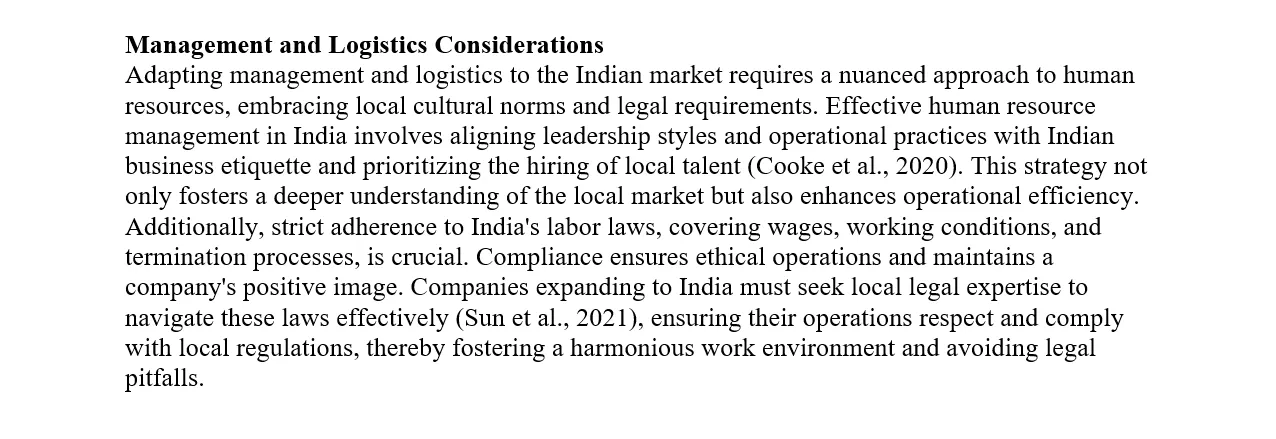
Describe the advantages and disadvantages of traditional modes of entry that would be most appropriate for entering your selected market.
Mode of Entry Considerations
In the last section of the INT 220 7-1 PROJECT SUBMISSION, we will discuss the entry modes in a global market.
· Joint Ventures offer local insights and shared risks but may result in less control over the brand and operations.
· Franchising allows rapid expansion with lower investment and risk but it depends heavily on finding reliable franchisees and can dilute brand control.
· Direct Investment provides complete control over operations and brand management but involves higher risk and significant investment.
Example

Each method has its unique advantages and challenges. The choice should align with the business’s strategic goals, risk tolerance, and operational capacity, ensuring a balanced approach to entering the vibrant yet complex Indian market.
Closing
INT 220 7-1 PROJECT SUBMISSION is the last part of the modules we discussed and solved in previous modules. Combine the 2-1 Module One, the 5-2 Module Two, and the 7-1 Project to create your final course project submission. Good luck
By following these guidelines and conducting thorough research, you can develop a comprehensive understanding of the process and considerations involved in expanding a business internationally, specifically in the Indian market.
FAQs
1. How can companies adapt their management to fit the Indian market?
Align leadership with Indian business etiquette and prioritize local talent hiring to understand the market and comply with labor laws. Refer to the 7-1 Project for more.
2. What are the critical considerations for choosing a mode of entry into India?
Evaluate joint ventures for local insights, franchising for rapid expansion with less risk, and direct investment for complete control. See INT 220 7-1 Project Submission for details.
3. Why is local legal expertise essential in India?
It’s crucial for navigating India’s labor laws and ensuring compliance, fostering a harmonious work environment, and maintaining a positive company image.
Step-By-Step Guide INT 220 8-1 Discussion: Reaching Career Goals
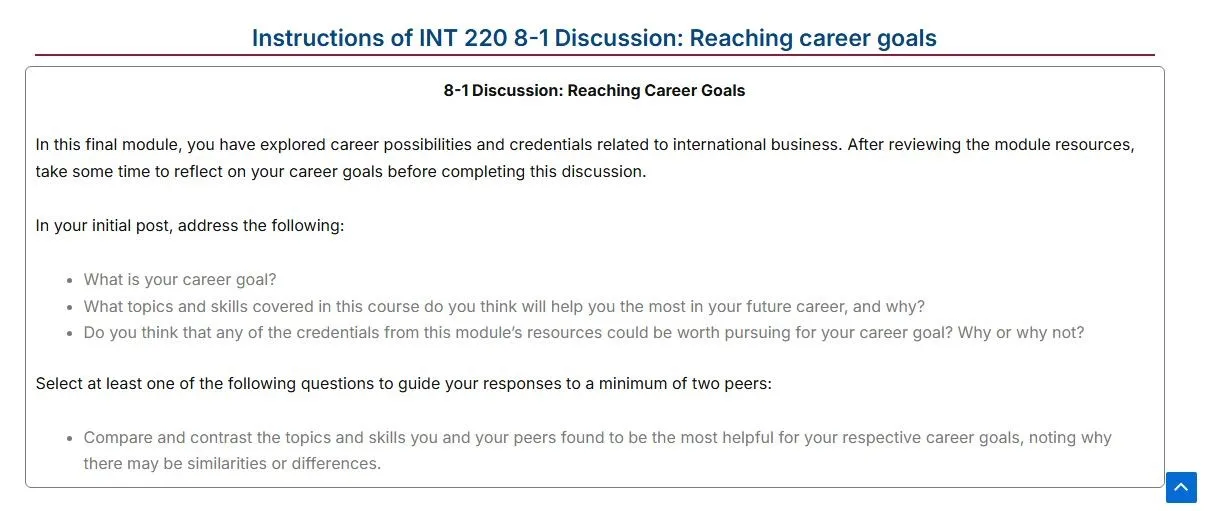
Introduction to INT 220 8-1 Discussion: Reaching career goals
This is the last task for the INT 220 course. In this discussion post, we reflect on our career goals and how our coursework aligns with these aspirations.
This Owlisdom How-To guide will help you navigate the process of leveraging course insights and skills for your future career, mainly focusing on the importance of personal reflection and strategic planning.
What is your career goal?
Identifying Your Career Goal
In this section of the INT 220 8-1 Discussion: Reaching career goals, Let’s look at how to identify your career goal.
Start by contemplating your long-term career objectives. Consider what excites you about international business and where you see yourself in the future. Defining a clear career goal is the first step in making informed decisions about your professional development.
What topics and skills covered in this course will help you the most in your future career, and why?
Leveraging Course Topics and Skills
In this section of the INT 220 8-1 Discussion: Reaching career goals, we need to discuss briefly the topics we studied throughout INT 220 and how this course has helped us explore our skills.
Reflect on the course modules that resonated most with you or offered valuable skills relevant to your career path. This could include understanding international market dynamics, cultural sensitivity in business practices, or mastering global marketing strategies. Relate these topics and skills directly to how they can propel you toward your career goal.
Could any credentials from this module’s resources be worth pursuing for your career goal? Why or why not?
Evaluating Credentials for Your Career
For this section of the INT 220 8-1 Discussion: Reaching career goals, we will evaluate the credentials for our chosen career.
Research and consider the credentials or certifications mentioned in the course. Evaluate their relevance to your chosen career path and how they might enhance your resume or professional profile. Deciding on the proper credentials involves considering their recognition in the field, the commitment required, and the potential ROI for career advancement.
Choose at least one of the following questions to guide your interactions with peers, aiming to deepen your understanding and perspective through dialogue. Compare and contrast the topics and skills you and your peers found most helpful for your career goals, noting why there may be similarities or differences.
Engaging with Peers
As the previous discussion posts mentioned, engaging with and answering peers’ queries is essential. Look at the detailed guidelines in the 1-1 Discussion to deliver professional responses to peers.
Response 01
Hey Max, nice post! I have found global supply chain management incredibly relevant to my goal in financial advising, especially in risk management. Seeing how others value digital marketing strategies for global branding is fascinating—showing how diverse skills fuel different paths in international business.Response 02
I have provided a sample response above; you can easily add your responses by using the sample.
Conclusion
Reflecting on your career goals and the insights gained from this course is a valuable exercise in personal and professional development. By identifying relevant skills, evaluating potential credentials, and engaging with peers, you’re laying a solid foundation for success in the international business arena. Remember, the journey of learning and growth continues well beyond the classroom—embrace every opportunity to expand your knowledge and network.
Closing
This guide will provide the guidelines to solve INT 220 8-1 Discussion: Reaching career goals. This is the last task and my last How-To Guide for this course. I hope you nail this course. Good luck!






